Kelly Jensen's Blog, page 94
January 14, 2015
January Debut YA Novels

Let's kick off another year of debut YA novels with a nice-sized round-up. Like always, "debut" here is in its purest definition: these are first-time books by first-time authors. I'm not including books by authors who are using or have used a pseudonym in the past or those who have written in other categories (adult, middle grade, etc.) in the past. Where we've reviewed the books, we've included links to them.
All descriptions are from WorldCat. If I'm missing any debuts out in January from traditional publishers, let me know in the comments.
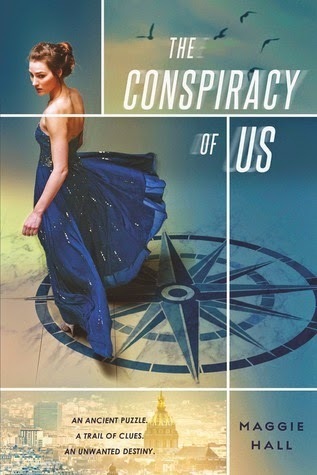
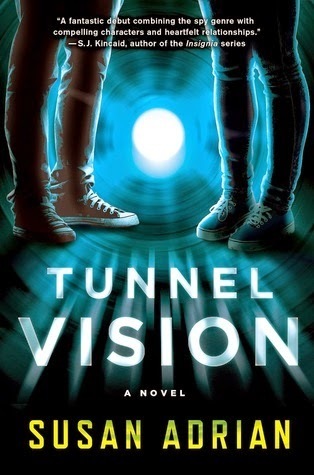
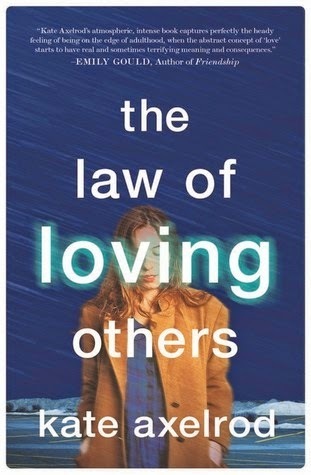
The Conspiracy of Us by Maggie Hall: When sixteen-year-old Avery West learns her family is part of a powerful and dangerous secret society, and that her own life is in danger, she must follow a trail of clues across Europe.
Tunnel Vision by Susan Adrian: When Jake Lukin, eighteen, reveals his psychic ability he is forced to become a government asset in order to keep his mother and sister safe, but Rachel, the girl he likes, tries to help him live his own life instead of tunneling through others.
The Law of Loving Others by Kate Axelrod: After Emma returns home from boarding school, she realizes her mother is suffering from a schizophrenic break, and suddenly, Emma's entire childhood and identity is called into question, pushing her to turn to her boyfriend, Daniel, for answers, but perhaps it is the brooding Phil who Emma meets while visiting her mother at the hospital who really understands her.
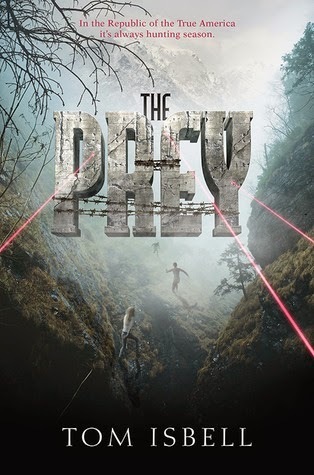
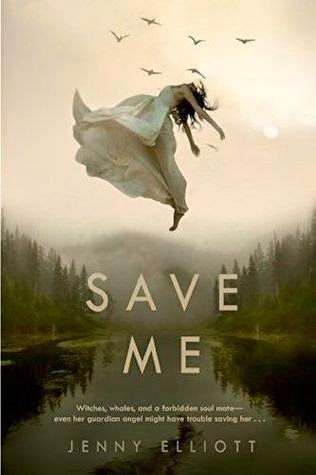
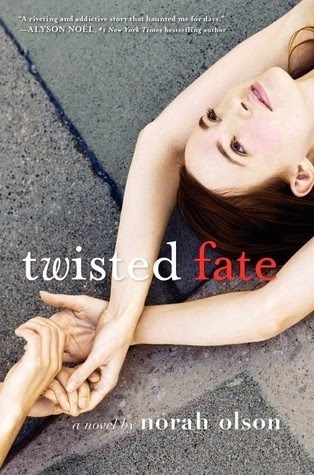
The Prey by Tom Isbell: After the apocalyptic Omega, a group of orphaned teen boys learn of their dark fate and escape, joining forces with twin girls who have been imprisoned for the 'good of the republic.' In their plight for freedom, these young heroes must find the best in themselves to fight against the worst in their enemies.
Save Me by Jenny Elliott: Liberty, Oregon, high school senior Cara is more interested in whale watching than dating until she develops a strong bond with newcomer David who is hiding a devastating secret, and meanwhile her best friend, Rachel, has begun practicing witchcraft, and to top it off, she has a stalker.
Twisted Fate by Norah Olson: Told from separate viewpoints, unfolds how sisters Sydney and Ally Tate's relationship changes as they get involved with their new neighbor, Graham, an artist with a videocamera who has a mysterious--and dangerous--past.
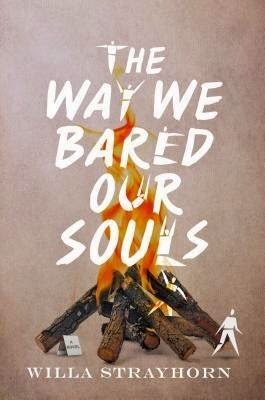
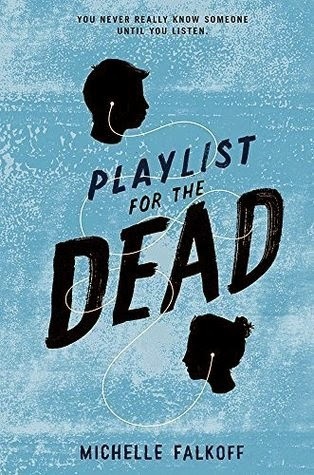
The Way We Bared Our Souls by Willa Strayhorn: Five teenagers sit around a bonfire in the middle of the New Mexico desert and when they participate in a ritual to trade totems as a symbol of shedding and adopting one another's sorrows, they think it is only an exercise, but in the morning they wake to find their burdens gone and replaced with someone else's.
Playlist for the Dead by Michelle Falkoff: After his best friend, Hayden, commits, suicide, fifteen-year-old Sam is determined to find out why--using the clues in the playlist Hayden left for him.







 Related StoriesOn Grief and Finding Love Unexpected: The Boy in the Black Suit by Jason Reynolds and The Carnival at Bray by Jessie Ann FoleyGet Genrefied: YA MemoirsAncient Historical YA
Related StoriesOn Grief and Finding Love Unexpected: The Boy in the Black Suit by Jason Reynolds and The Carnival at Bray by Jessie Ann FoleyGet Genrefied: YA MemoirsAncient Historical YA
Published on January 14, 2015 22:00
January 13, 2015
Reviews: Two Recent Historical Fiction Listens
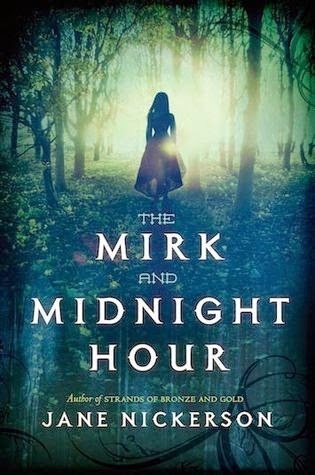
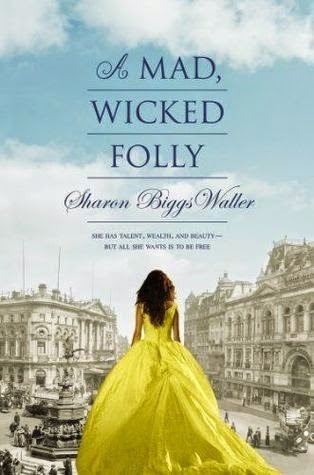
The Mirk and Midnight Hour by Jane Nickerson
I listened to Nickerson's first novel, Strands of Bronze and Gold (a re-telling of Bluebeard set in the antebellum South), and liked it well enough. Her second novel is in the South during the Civil War and re-tells a different legend: Tam Lin. Nickerson's writing is slow with an emphasis on developing setting and building atmosphere. It worked pretty well in her first, but it's less successful here. A full third of the book is purely expository. The protagonist, Violet, lives on a small plantation in the South. Her twin brother was recently killed in the war and her father remarried, then went off to fight himself, leaving Violet with a new stepmother and stepsister along with two male cousins who have come to stay. Nickerson spends a lot of time getting us acquainted with the farm, called Scuppernong, and its inhabitants, including several slaves.
About halfway through the book, Violet meets a wounded Union soldier named Thomas Lind. She dare not take him to a hospital, since he'd simply be taken captive. Thomas is being kept alive by a group of free Black people who practice hoodoo and are obviously preparing Thomas for some sort of ritual, which comes to a head at the end of the novel. This storyline is juggled awkwardly with that of the cousins at Scuppernong, one of them a young man whose intentions toward Violet and his younger cousin are anything but charitable. This would have been a stronger novel had Nickerson focused on one of these plotlines; as they exist now, they seem to be fighting each other for prominence. They don't come together in any way by the end.
Violet's voice is heavily accented and seems a little forced. I don't think the narrator - Dorothy Dillingham Blue - has such a strong Southern accent naturally and it just comes across as fake. I also find books featuring hoodoo awkward when written from a white perspective, and I'm perhaps a bit tired of white Southern Civil War stories, where the white protagonist comes to the realization that people should not be owned and is lauded for it. It's a hazard of Civil War historical fiction and it's become cliche. A more nuanced and interesting take on slavery in a Southern plantation is Delia Sherman's The Freedom Maze .
I don't think this will appeal much to readers interested in Tam Lin; the retelling isn't hugely obvious and it doesn't even come into play until halfway through the book. Readers looking for setting and atmosphere may enjoy it, as well as readers who can't get enough of this time period - and there are certainly those readers out there. Violet herself is an incredibly naive narrator, which may be accurate for this era when girls were meant to be quite sheltered, but it also slows the novel down some and keeps certain conclusions (mostly the cousin being a bad egg) from coming to light for much too long. I wouldn't call this a first pick.
A Mad, Wicked Folly by Sharon Biggs Waller
This novel is set in 1909 London and focuses on a teenage girl who is determined to become an artist. Vicky comes from a wealthy family and they are determined that she give up her foolish dreams and get married. She's taking an illicit art class in Paris while she's supposed to be at finishing school and she decides to pose nude - it's a life drawing class, the model failed to show, and all the other male students had already posed. Of course, her act is found out by her parents and she's sent back home to London in scandal.
Her parents arrange for an engagement to a young man, a gambler who seems nice and whom Vicky believes may just be progressive enough to pay for tuition at the Royal College of Art. Vicky doesn't mind marrying him if it means she can pursue her dream. The problem is, she starts to fall in love with a young police officer she met while sketching the suffragettes at a rally. Her life becomes a series of deceptions - sneaking away to meet the police officer (who has become her muse), sketching the suffragettes and eventually using her artistic talent to help them (a cause with which her parents heartily disagree), and applying for a scholarship to the art college.
Waller does a good job of showing Vicky as being progressive for her time but also caught up in its prevailing ideals. She can't see a way to achieve her dreams beyond a man agreeing to give it to her. At the same time, she keeps pushing for a way to make it happen, and some of her actions would be considered progressive even for our own time (posing nude, for example). The suffragette storyline is a great subplot and helps give Vicky an arc - she realizes she has to fight for this cause if she ever wants to make her own dreams come true, that she can't rely on others to do it for her. She's a strong-willed protagonist who also seems like she belongs to her time, a fine line to walk in feminist historical fiction.
This is a great example of what historical fiction can be: a snapshot of a certain place at a certain time featuring an interesting protagonist in interesting circumstances. Readers wanting to know more about the suffragette movement in England would do well to pick this up - it features a number of real prominent figures in the movement and focuses on the force-feeding of the imprisoned women, a real-life occurrence which I know will be new to many readers. Katharine McEwan narrates Vicky's story well, injecting personality into Vicky's voice and slightly voicing the other characters.
Both audiobooks borrowed from my local library.







 Related StoriesOn Grief and Finding Love Unexpected: The Boy in the Black Suit by Jason Reynolds and The Carnival at Bray by Jessie Ann FoleyA Few Cybils Reads - Part XGet Genrefied: YA Memoirs
Related StoriesOn Grief and Finding Love Unexpected: The Boy in the Black Suit by Jason Reynolds and The Carnival at Bray by Jessie Ann FoleyA Few Cybils Reads - Part XGet Genrefied: YA Memoirs
Published on January 13, 2015 22:00
January 12, 2015
Getting Started with Comics: Guest Post from Becca and Allison of This Week in Ladies
We're super excited about the guest post we have to share today. Becca and Allison are two librarians who Kimberly and I went to the University of Texas iSchool with back in the day, and they're the voices and brains behind the awesome "This Week in Ladies" podcast, which is all about women in pop culture. They asked if we'd be interested in a guest post about getting teens -- and new readers who aren't quite teens anymore -- started with reading comics.
Of course we are!
If you're looking to get started or want to help other readers kick off a comics reading spree, this is the post for you.

Becca and Allison, the team behind the podcast This Week in Ladies, are a couple of punk ass book jockeys who live in Austin, Texas. They spend their time eating queso, haunting their local comic book shop, and getting way too invested in pub trivia.
So you think you’d like to try comics, but it seems like... a lot. We get it. The entry barrier to comics can be really high, especially if you’re reading about characters who’ve been around fifty or more years. Figuring out what to read, and in what order, can be really complicated.
We were in the same place two years ago. After Marvel’s The Avengers came out, though, we had Avenger fever and dove into the world of comics, slowly figuring out how to parse this format and this industry. Two years ago, neither of us knew what a pull list was, and now we haunt our local comic shop every week.
So we’ve compiled a list of recommended comics for you, divided into two categories: Marvel All In, and Badass Ladies. (Sorry, DC.) Our Marvel recommendations will help you dive in further if you like the movies, the TV show, or People’s Sexiest Man Alive. Badass Ladies recs are for people who need more badass ladies in their lives. Which is all of us.
Want to read some of these? Most have been compiled into trades (that’s when a few, usually six, monthly issues get put into a softcover book together), which you can purchase from your local comic book shop, or borrow from your local library.
And, if this leads you down the rabbit hole, you can always check out our podcast, This Week in Ladies. Every (other) week, we talk comics, books, and pop culture in general from a feminist perspective.
Marvel All In
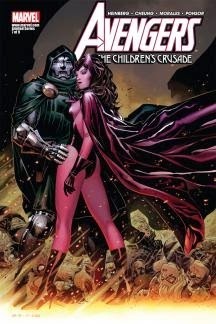 Young AvengersVol. 1, Vol. 2, Vol. 3Writer: Kieron Gillen, Artist: Jamie McKelvieThe Young Avengers, who first appeared in 2005, were created by Allan Heinberg and Jim Cheung. They are a ragtag group of teen heroes modeled on the original flavor Avengers (Kate “Hawkeye” Bishop, for example, shoots arrows, wears purple and has no superpowers), who step up to fill the superhero void created by the Avengers: Disassembled storyline. Though the 2013 series occurs in the same continuity, you can still jump in here without being lost. Gillen’s snappy dialogue, filled with slang and pop culture references that feel totally natural, combined with McKelvie’s clean, cool art and Matthew Wilson’s vibrant coloring, creates a series that feels young, fresh and fun, but not frivolous. World-saving is still serious business, after all, even for teens.
Young AvengersVol. 1, Vol. 2, Vol. 3Writer: Kieron Gillen, Artist: Jamie McKelvieThe Young Avengers, who first appeared in 2005, were created by Allan Heinberg and Jim Cheung. They are a ragtag group of teen heroes modeled on the original flavor Avengers (Kate “Hawkeye” Bishop, for example, shoots arrows, wears purple and has no superpowers), who step up to fill the superhero void created by the Avengers: Disassembled storyline. Though the 2013 series occurs in the same continuity, you can still jump in here without being lost. Gillen’s snappy dialogue, filled with slang and pop culture references that feel totally natural, combined with McKelvie’s clean, cool art and Matthew Wilson’s vibrant coloring, creates a series that feels young, fresh and fun, but not frivolous. World-saving is still serious business, after all, even for teens.
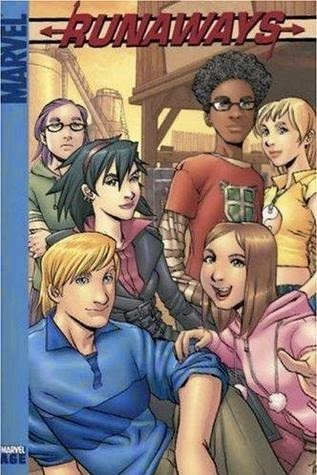 RunawaysVol. 1 [Wikipedia’s your best bet to follow the progression of this one]Writer: Brian K. Vaughan (also written by Terry Moore and some guy you’ve probably never heard of named Joss Whedon), Illustrator: VariousThe Runaways are a ragtag group of superpowered teens whose parents are part of an evil organization called the Pride. Wanting nothing to do with their parents’ bad guy ways, the teens run away together, and adventure ensues. While this storyline is situated in the same Marvel universe as those involving the major heroes (the Runaways, for example, encounter the Young Avengers during the events of Civil War), you don’t need any knowledge of that world at all to enjoy Runaways. In fact, this book will introduce you to a lot of the Marvel characters and mythology in a really accessible way. Still not sold? One of the Runaways has a dinosaur sidekick named Old Lace. (Sub-rec: anything ever written by Brian K. Vaughan)
RunawaysVol. 1 [Wikipedia’s your best bet to follow the progression of this one]Writer: Brian K. Vaughan (also written by Terry Moore and some guy you’ve probably never heard of named Joss Whedon), Illustrator: VariousThe Runaways are a ragtag group of superpowered teens whose parents are part of an evil organization called the Pride. Wanting nothing to do with their parents’ bad guy ways, the teens run away together, and adventure ensues. While this storyline is situated in the same Marvel universe as those involving the major heroes (the Runaways, for example, encounter the Young Avengers during the events of Civil War), you don’t need any knowledge of that world at all to enjoy Runaways. In fact, this book will introduce you to a lot of the Marvel characters and mythology in a really accessible way. Still not sold? One of the Runaways has a dinosaur sidekick named Old Lace. (Sub-rec: anything ever written by Brian K. Vaughan)
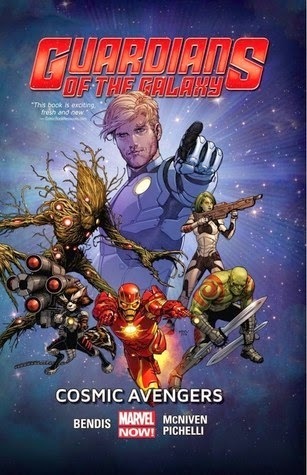 Guardians of the GalaxyVol. 1 (and ongoing)Writer: Brian Michael Bendis, Artists: Steve McNiven, Sara PichelliChances are you’ve heard of the Guardians, as they did star in the second-highest grossing movie of the year. You probably already know they’re a ragtag group of space bandits who’ve taken it upon themselves to, well, guard the galaxy. While I’m not sure I’d say the book is better than the movie, it’s definitely funnier. It also has four fully-realized, interesting characters with back stories and relatable motivation, while the movie maxed out at two (Drax, unfortunately, is still lacking). The Guardians are a bit grittier than the Avengers, and more likely to justify questionable means with righteous ends, of which they are well aware, making this a little more thoughtful than your standard space action/adventure/comedy.
Guardians of the GalaxyVol. 1 (and ongoing)Writer: Brian Michael Bendis, Artists: Steve McNiven, Sara PichelliChances are you’ve heard of the Guardians, as they did star in the second-highest grossing movie of the year. You probably already know they’re a ragtag group of space bandits who’ve taken it upon themselves to, well, guard the galaxy. While I’m not sure I’d say the book is better than the movie, it’s definitely funnier. It also has four fully-realized, interesting characters with back stories and relatable motivation, while the movie maxed out at two (Drax, unfortunately, is still lacking). The Guardians are a bit grittier than the Avengers, and more likely to justify questionable means with righteous ends, of which they are well aware, making this a little more thoughtful than your standard space action/adventure/comedy.
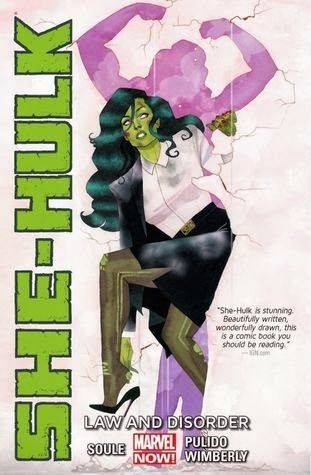 She-HulkVol. 1, Vol. 2Writer: Charles Soule, Artist: Javier PulidoSoule’s She-Hulk has a lot in common with Matt Fraction’s Hawkeye, including art by Pulido. Like Hawkeye, She-Hulk is about what Jennifer Walters does when she’s not with the Avengers, which is practice law. After falling out with her law firm, Walters strikes out on her own, focusing on cases that involve the superhero community. She works with a ragtag group of fellow badass ladies--landlord and former mutant Sharon, investigator and costumed crusader Patsy, and paralegal-with-a-past Angie. With this cast of characters, Soule soundly answers that age-old and infuriating question: Can authors write believable characters of the opposite sex? If you’re looking for a book in which Walters Hulks out a lot, this one isn’t for you. If you’re looking for a book about a mature, adult woman who’s good at her job and has healthy relationships with friends and colleagues, give it a go.
She-HulkVol. 1, Vol. 2Writer: Charles Soule, Artist: Javier PulidoSoule’s She-Hulk has a lot in common with Matt Fraction’s Hawkeye, including art by Pulido. Like Hawkeye, She-Hulk is about what Jennifer Walters does when she’s not with the Avengers, which is practice law. After falling out with her law firm, Walters strikes out on her own, focusing on cases that involve the superhero community. She works with a ragtag group of fellow badass ladies--landlord and former mutant Sharon, investigator and costumed crusader Patsy, and paralegal-with-a-past Angie. With this cast of characters, Soule soundly answers that age-old and infuriating question: Can authors write believable characters of the opposite sex? If you’re looking for a book in which Walters Hulks out a lot, this one isn’t for you. If you’re looking for a book about a mature, adult woman who’s good at her job and has healthy relationships with friends and colleagues, give it a go.
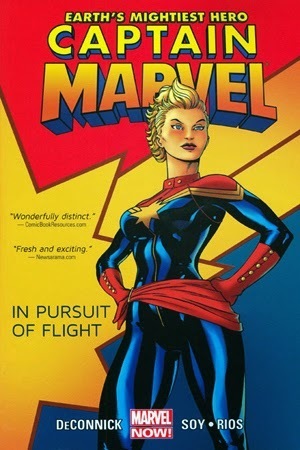 Captain MarvelVol. 1, Vol. 2, reboot Vol. 1Writer: Kelly Sue DeConnick, Artists: Dexter Soy, Emma Rios, Filipe Andrade, David LopezFor starters: July 6, 2018. Carol Danvers, originally created as overtly feminist superhero Ms. Marvel in the 1970s, comes into her own in her new solo title, which debuted in 2012. The former Air Force pilot leads a ragtag team of veterans, nerds, and little girls as they battle evil forces at home and across the galaxy. Carol is smart, fearless, caring, and prefers punching to talking. Her best friend, Spider-Woman, shows up for a few issues, too. DeConnick pairs with a few illustrators over the series, and each one brings something different to Carol (though her hair is always crazy). Read this to see why the Carol Corps is the most dedicated fanbase of any Marvel character.
Captain MarvelVol. 1, Vol. 2, reboot Vol. 1Writer: Kelly Sue DeConnick, Artists: Dexter Soy, Emma Rios, Filipe Andrade, David LopezFor starters: July 6, 2018. Carol Danvers, originally created as overtly feminist superhero Ms. Marvel in the 1970s, comes into her own in her new solo title, which debuted in 2012. The former Air Force pilot leads a ragtag team of veterans, nerds, and little girls as they battle evil forces at home and across the galaxy. Carol is smart, fearless, caring, and prefers punching to talking. Her best friend, Spider-Woman, shows up for a few issues, too. DeConnick pairs with a few illustrators over the series, and each one brings something different to Carol (though her hair is always crazy). Read this to see why the Carol Corps is the most dedicated fanbase of any Marvel character.
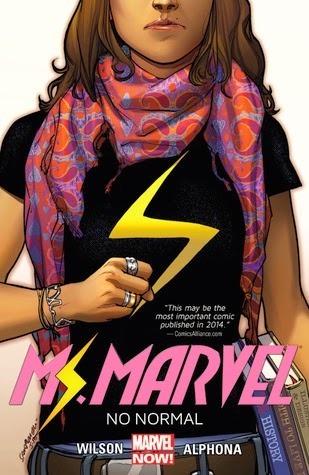 Ms. MarvelVol. 1 (and ongoing)Writer: G. Willow Wilson, Artist: Adrian AlphonaA ragtag group of good students in New Jersey battle supervillains, alligators in the sewer, and strict parents. The new Ms. Marvel is Kamala Khan, a Pakistani-American Muslim teenager living in Jersey City who LOVES superheroes (some of her fanfiction has received A LOT of hits, thank you very much). Now that Carol Danvers has traded in for her new name, Marvel created a brand new character to take over the old moniker (inspired by Marvel editor Sana Amanat’s teen years). Kamala’s faith and culture absolutely inform her character and her storylines, but she’s a whole person, not just a caricature or an afterschool special about diversity -- she’s funny, earnest, and deeply weird.
Ms. MarvelVol. 1 (and ongoing)Writer: G. Willow Wilson, Artist: Adrian AlphonaA ragtag group of good students in New Jersey battle supervillains, alligators in the sewer, and strict parents. The new Ms. Marvel is Kamala Khan, a Pakistani-American Muslim teenager living in Jersey City who LOVES superheroes (some of her fanfiction has received A LOT of hits, thank you very much). Now that Carol Danvers has traded in for her new name, Marvel created a brand new character to take over the old moniker (inspired by Marvel editor Sana Amanat’s teen years). Kamala’s faith and culture absolutely inform her character and her storylines, but she’s a whole person, not just a caricature or an afterschool special about diversity -- she’s funny, earnest, and deeply weird.
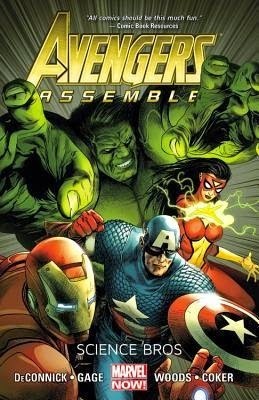 Avengers AssembleVol. 2, Vol. 3, Vol. 4 Writer: Kelly Sue DeConnick, Artist: Stefano CaselliAvengers Assemble is the comic Marvel debuted to draw in fans of the movies, so it features a ragtag team you may have seen a blockbuster summer film about. During Kelly Sue DeConnick’s run, the comic featured a variety of teamups, including a number of Avengers introducing teenager Spider-Girl to the realities of superhero life and Iron Man and the Hulk making a competition out of rescuing a scientist friend who’s been captured by villains (loser walks through downtown Manhattan naked). Caselli’s crisp, bright, clean-lined art is the perfect complement to this story, which, even though it’s about superheroes, is among the most real things we read. Funny, but always with a fantastic heart.
Avengers AssembleVol. 2, Vol. 3, Vol. 4 Writer: Kelly Sue DeConnick, Artist: Stefano CaselliAvengers Assemble is the comic Marvel debuted to draw in fans of the movies, so it features a ragtag team you may have seen a blockbuster summer film about. During Kelly Sue DeConnick’s run, the comic featured a variety of teamups, including a number of Avengers introducing teenager Spider-Girl to the realities of superhero life and Iron Man and the Hulk making a competition out of rescuing a scientist friend who’s been captured by villains (loser walks through downtown Manhattan naked). Caselli’s crisp, bright, clean-lined art is the perfect complement to this story, which, even though it’s about superheroes, is among the most real things we read. Funny, but always with a fantastic heart.
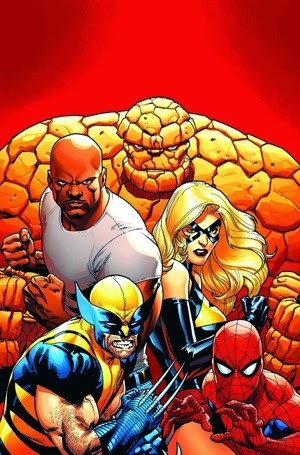
New AvengersWriter: Brian Michael Bendis, Artists: VariousStarting in 2005, New Avengers featured a ragtag crew of every Avenger you’ve ever heard of (and a bunch you haven’t). The storyline came out of the aftermath of the Avengers disbanding after failing to stop the Scarlet Witch (read up on this before Avengers: Age of Ultron comes out!). Over the five years Bendis wrote it, they tackled the Civil War (to be featured in Captain America 3), the rise and fall of intelligence agencies (and how to navigate allegiance to those agencies), seeing old friends go evil, and how to be married and a superhero at the same time. This is your sweeping epic melodrama. (New Avengers is the most sprawling thing we’re recommending here, and honestly, the Wikipedia page is probably your best guide to the trades.)
Badass Ladies
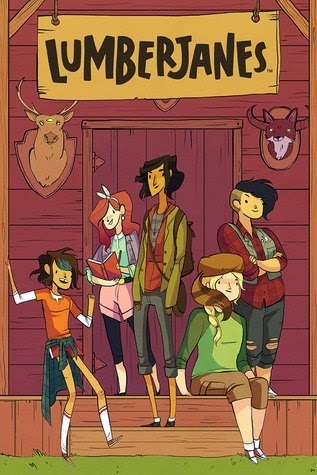
LumberjanesVol. 1 (and ongoing)Writers: Noelle Stevenson & Grace Ellis, Artist: Brooke AllenDid you like the “Pawnee Rangers” episode of Parks & Recreation? Do you wish it had more magic? Then oh my bell hooks, is Lumberjanes the comic for you. Featuring a ragtag group of campers at a summer camp with some seriously mysterious happenings, Lumberjanes is funny, silly, and deeply weird. Our campers battle werewolves, gods, controlling counselors, and hypnotized boy campers, earning a lot of great badges along the way.
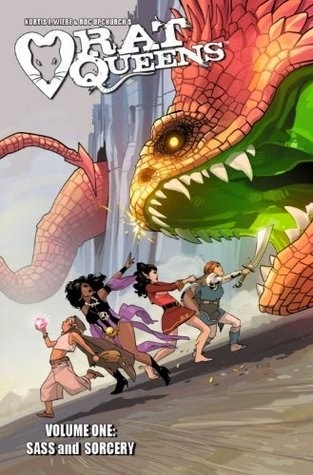
Rat QueensVol. 1 (and ongoing)Writer: Kurtis J. Wiebe, Artist: Roc UpchurchI like to think of the Rat Queens as the Lumberjanes after they grow up and discover sex, drugs and rock ‘n’ roll. As you might imagine, then, this one has more mature content than the rest of the titles on our list. On its face, Rat Queens is a fantasy book about a ragtag group of marauders--sorceress Hannah, warrior Violet, healer Dee, and thief Betty. But, it’s really about found family, gender and sexuality, growing up and kicking ass. Oh, and it’s hilariously funny.
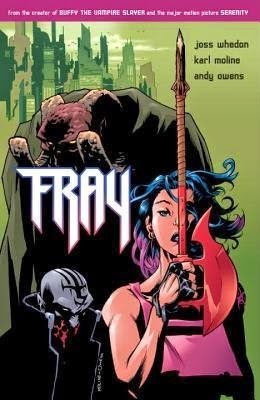
FrayComplete seriesWriter: Joss Whedon, Artist: Karl MolineFray is about a ragtag group of...well, actually, Melaka Fray is kind of a loner. Unlike her predecessor Buffy Summers, she doesn’t have a Scooby Gang. Or a Watcher. Fray takes place well into the flying car-future. There hasn’t been a Slayer in two hundred years and nobody even knows what vampires are, so no previous knowledge of Buffy the Vampire Slayer is required to enjoy this book (unlike this review). The book’s got a lot of Whedon hallmarks--Badass lady? Check. Quick-paced dialogue heavy on the fictional slang? Check. Death of a beloved character? CHECK. The art is both colorful and gritty, perfectly capturing the atmosphere of Fray’s dystopian future.
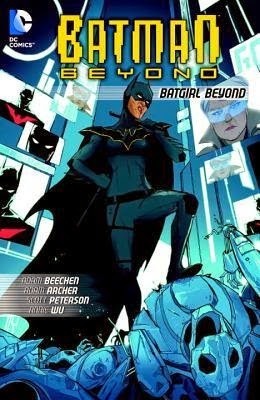
Batgirl BeyondTradeWriter: Scott Peterson, Artist: Annie WuOK, DC, you get this one. The Batman Beyond universe is set in a future where Bruce Wayne is a bitter old man and Neo-Gotham is once again the lawless place of his youth. High schooler Terry McGinnis is the new Batman, and former Batgirl Barbara Gordon has succeeded her father as police commissioner. In Batgirl Beyond -- tragically, a single issue, and not an epic that went on forever -- Barbara Gordon meets a new young (woman of color!) Batgirl on the rough side of town, and together they take on a evil business dude. Annie Wu designed the costume, and designed it to look like it was created by the character, making it unlike a lot of other female superhero costumes. This Batgirl is funny and cocky and it’s a damn shame we never got to see more of her.







 Related StoriesLet's Move Beyond the Gender Binary: Guest Post by I. W. GregorioBoy Meets Girl: Guest Post by Lamar Giles (author of Fake ID and Endangered)Socioeconomic Class in Contemporary YA Lit: Where Are The Poor Teens? Guest Post by Librarian Faythe Arrendondo
Related StoriesLet's Move Beyond the Gender Binary: Guest Post by I. W. GregorioBoy Meets Girl: Guest Post by Lamar Giles (author of Fake ID and Endangered)Socioeconomic Class in Contemporary YA Lit: Where Are The Poor Teens? Guest Post by Librarian Faythe Arrendondo
Of course we are!
If you're looking to get started or want to help other readers kick off a comics reading spree, this is the post for you.

Becca and Allison, the team behind the podcast This Week in Ladies, are a couple of punk ass book jockeys who live in Austin, Texas. They spend their time eating queso, haunting their local comic book shop, and getting way too invested in pub trivia.
So you think you’d like to try comics, but it seems like... a lot. We get it. The entry barrier to comics can be really high, especially if you’re reading about characters who’ve been around fifty or more years. Figuring out what to read, and in what order, can be really complicated.
We were in the same place two years ago. After Marvel’s The Avengers came out, though, we had Avenger fever and dove into the world of comics, slowly figuring out how to parse this format and this industry. Two years ago, neither of us knew what a pull list was, and now we haunt our local comic shop every week.
So we’ve compiled a list of recommended comics for you, divided into two categories: Marvel All In, and Badass Ladies. (Sorry, DC.) Our Marvel recommendations will help you dive in further if you like the movies, the TV show, or People’s Sexiest Man Alive. Badass Ladies recs are for people who need more badass ladies in their lives. Which is all of us.
Want to read some of these? Most have been compiled into trades (that’s when a few, usually six, monthly issues get put into a softcover book together), which you can purchase from your local comic book shop, or borrow from your local library.
And, if this leads you down the rabbit hole, you can always check out our podcast, This Week in Ladies. Every (other) week, we talk comics, books, and pop culture in general from a feminist perspective.
Marvel All In
 Young AvengersVol. 1, Vol. 2, Vol. 3Writer: Kieron Gillen, Artist: Jamie McKelvieThe Young Avengers, who first appeared in 2005, were created by Allan Heinberg and Jim Cheung. They are a ragtag group of teen heroes modeled on the original flavor Avengers (Kate “Hawkeye” Bishop, for example, shoots arrows, wears purple and has no superpowers), who step up to fill the superhero void created by the Avengers: Disassembled storyline. Though the 2013 series occurs in the same continuity, you can still jump in here without being lost. Gillen’s snappy dialogue, filled with slang and pop culture references that feel totally natural, combined with McKelvie’s clean, cool art and Matthew Wilson’s vibrant coloring, creates a series that feels young, fresh and fun, but not frivolous. World-saving is still serious business, after all, even for teens.
Young AvengersVol. 1, Vol. 2, Vol. 3Writer: Kieron Gillen, Artist: Jamie McKelvieThe Young Avengers, who first appeared in 2005, were created by Allan Heinberg and Jim Cheung. They are a ragtag group of teen heroes modeled on the original flavor Avengers (Kate “Hawkeye” Bishop, for example, shoots arrows, wears purple and has no superpowers), who step up to fill the superhero void created by the Avengers: Disassembled storyline. Though the 2013 series occurs in the same continuity, you can still jump in here without being lost. Gillen’s snappy dialogue, filled with slang and pop culture references that feel totally natural, combined with McKelvie’s clean, cool art and Matthew Wilson’s vibrant coloring, creates a series that feels young, fresh and fun, but not frivolous. World-saving is still serious business, after all, even for teens. RunawaysVol. 1 [Wikipedia’s your best bet to follow the progression of this one]Writer: Brian K. Vaughan (also written by Terry Moore and some guy you’ve probably never heard of named Joss Whedon), Illustrator: VariousThe Runaways are a ragtag group of superpowered teens whose parents are part of an evil organization called the Pride. Wanting nothing to do with their parents’ bad guy ways, the teens run away together, and adventure ensues. While this storyline is situated in the same Marvel universe as those involving the major heroes (the Runaways, for example, encounter the Young Avengers during the events of Civil War), you don’t need any knowledge of that world at all to enjoy Runaways. In fact, this book will introduce you to a lot of the Marvel characters and mythology in a really accessible way. Still not sold? One of the Runaways has a dinosaur sidekick named Old Lace. (Sub-rec: anything ever written by Brian K. Vaughan)
RunawaysVol. 1 [Wikipedia’s your best bet to follow the progression of this one]Writer: Brian K. Vaughan (also written by Terry Moore and some guy you’ve probably never heard of named Joss Whedon), Illustrator: VariousThe Runaways are a ragtag group of superpowered teens whose parents are part of an evil organization called the Pride. Wanting nothing to do with their parents’ bad guy ways, the teens run away together, and adventure ensues. While this storyline is situated in the same Marvel universe as those involving the major heroes (the Runaways, for example, encounter the Young Avengers during the events of Civil War), you don’t need any knowledge of that world at all to enjoy Runaways. In fact, this book will introduce you to a lot of the Marvel characters and mythology in a really accessible way. Still not sold? One of the Runaways has a dinosaur sidekick named Old Lace. (Sub-rec: anything ever written by Brian K. Vaughan) Guardians of the GalaxyVol. 1 (and ongoing)Writer: Brian Michael Bendis, Artists: Steve McNiven, Sara PichelliChances are you’ve heard of the Guardians, as they did star in the second-highest grossing movie of the year. You probably already know they’re a ragtag group of space bandits who’ve taken it upon themselves to, well, guard the galaxy. While I’m not sure I’d say the book is better than the movie, it’s definitely funnier. It also has four fully-realized, interesting characters with back stories and relatable motivation, while the movie maxed out at two (Drax, unfortunately, is still lacking). The Guardians are a bit grittier than the Avengers, and more likely to justify questionable means with righteous ends, of which they are well aware, making this a little more thoughtful than your standard space action/adventure/comedy.
Guardians of the GalaxyVol. 1 (and ongoing)Writer: Brian Michael Bendis, Artists: Steve McNiven, Sara PichelliChances are you’ve heard of the Guardians, as they did star in the second-highest grossing movie of the year. You probably already know they’re a ragtag group of space bandits who’ve taken it upon themselves to, well, guard the galaxy. While I’m not sure I’d say the book is better than the movie, it’s definitely funnier. It also has four fully-realized, interesting characters with back stories and relatable motivation, while the movie maxed out at two (Drax, unfortunately, is still lacking). The Guardians are a bit grittier than the Avengers, and more likely to justify questionable means with righteous ends, of which they are well aware, making this a little more thoughtful than your standard space action/adventure/comedy. She-HulkVol. 1, Vol. 2Writer: Charles Soule, Artist: Javier PulidoSoule’s She-Hulk has a lot in common with Matt Fraction’s Hawkeye, including art by Pulido. Like Hawkeye, She-Hulk is about what Jennifer Walters does when she’s not with the Avengers, which is practice law. After falling out with her law firm, Walters strikes out on her own, focusing on cases that involve the superhero community. She works with a ragtag group of fellow badass ladies--landlord and former mutant Sharon, investigator and costumed crusader Patsy, and paralegal-with-a-past Angie. With this cast of characters, Soule soundly answers that age-old and infuriating question: Can authors write believable characters of the opposite sex? If you’re looking for a book in which Walters Hulks out a lot, this one isn’t for you. If you’re looking for a book about a mature, adult woman who’s good at her job and has healthy relationships with friends and colleagues, give it a go.
She-HulkVol. 1, Vol. 2Writer: Charles Soule, Artist: Javier PulidoSoule’s She-Hulk has a lot in common with Matt Fraction’s Hawkeye, including art by Pulido. Like Hawkeye, She-Hulk is about what Jennifer Walters does when she’s not with the Avengers, which is practice law. After falling out with her law firm, Walters strikes out on her own, focusing on cases that involve the superhero community. She works with a ragtag group of fellow badass ladies--landlord and former mutant Sharon, investigator and costumed crusader Patsy, and paralegal-with-a-past Angie. With this cast of characters, Soule soundly answers that age-old and infuriating question: Can authors write believable characters of the opposite sex? If you’re looking for a book in which Walters Hulks out a lot, this one isn’t for you. If you’re looking for a book about a mature, adult woman who’s good at her job and has healthy relationships with friends and colleagues, give it a go. Captain MarvelVol. 1, Vol. 2, reboot Vol. 1Writer: Kelly Sue DeConnick, Artists: Dexter Soy, Emma Rios, Filipe Andrade, David LopezFor starters: July 6, 2018. Carol Danvers, originally created as overtly feminist superhero Ms. Marvel in the 1970s, comes into her own in her new solo title, which debuted in 2012. The former Air Force pilot leads a ragtag team of veterans, nerds, and little girls as they battle evil forces at home and across the galaxy. Carol is smart, fearless, caring, and prefers punching to talking. Her best friend, Spider-Woman, shows up for a few issues, too. DeConnick pairs with a few illustrators over the series, and each one brings something different to Carol (though her hair is always crazy). Read this to see why the Carol Corps is the most dedicated fanbase of any Marvel character.
Captain MarvelVol. 1, Vol. 2, reboot Vol. 1Writer: Kelly Sue DeConnick, Artists: Dexter Soy, Emma Rios, Filipe Andrade, David LopezFor starters: July 6, 2018. Carol Danvers, originally created as overtly feminist superhero Ms. Marvel in the 1970s, comes into her own in her new solo title, which debuted in 2012. The former Air Force pilot leads a ragtag team of veterans, nerds, and little girls as they battle evil forces at home and across the galaxy. Carol is smart, fearless, caring, and prefers punching to talking. Her best friend, Spider-Woman, shows up for a few issues, too. DeConnick pairs with a few illustrators over the series, and each one brings something different to Carol (though her hair is always crazy). Read this to see why the Carol Corps is the most dedicated fanbase of any Marvel character. Ms. MarvelVol. 1 (and ongoing)Writer: G. Willow Wilson, Artist: Adrian AlphonaA ragtag group of good students in New Jersey battle supervillains, alligators in the sewer, and strict parents. The new Ms. Marvel is Kamala Khan, a Pakistani-American Muslim teenager living in Jersey City who LOVES superheroes (some of her fanfiction has received A LOT of hits, thank you very much). Now that Carol Danvers has traded in for her new name, Marvel created a brand new character to take over the old moniker (inspired by Marvel editor Sana Amanat’s teen years). Kamala’s faith and culture absolutely inform her character and her storylines, but she’s a whole person, not just a caricature or an afterschool special about diversity -- she’s funny, earnest, and deeply weird.
Ms. MarvelVol. 1 (and ongoing)Writer: G. Willow Wilson, Artist: Adrian AlphonaA ragtag group of good students in New Jersey battle supervillains, alligators in the sewer, and strict parents. The new Ms. Marvel is Kamala Khan, a Pakistani-American Muslim teenager living in Jersey City who LOVES superheroes (some of her fanfiction has received A LOT of hits, thank you very much). Now that Carol Danvers has traded in for her new name, Marvel created a brand new character to take over the old moniker (inspired by Marvel editor Sana Amanat’s teen years). Kamala’s faith and culture absolutely inform her character and her storylines, but she’s a whole person, not just a caricature or an afterschool special about diversity -- she’s funny, earnest, and deeply weird. Avengers AssembleVol. 2, Vol. 3, Vol. 4 Writer: Kelly Sue DeConnick, Artist: Stefano CaselliAvengers Assemble is the comic Marvel debuted to draw in fans of the movies, so it features a ragtag team you may have seen a blockbuster summer film about. During Kelly Sue DeConnick’s run, the comic featured a variety of teamups, including a number of Avengers introducing teenager Spider-Girl to the realities of superhero life and Iron Man and the Hulk making a competition out of rescuing a scientist friend who’s been captured by villains (loser walks through downtown Manhattan naked). Caselli’s crisp, bright, clean-lined art is the perfect complement to this story, which, even though it’s about superheroes, is among the most real things we read. Funny, but always with a fantastic heart.
Avengers AssembleVol. 2, Vol. 3, Vol. 4 Writer: Kelly Sue DeConnick, Artist: Stefano CaselliAvengers Assemble is the comic Marvel debuted to draw in fans of the movies, so it features a ragtag team you may have seen a blockbuster summer film about. During Kelly Sue DeConnick’s run, the comic featured a variety of teamups, including a number of Avengers introducing teenager Spider-Girl to the realities of superhero life and Iron Man and the Hulk making a competition out of rescuing a scientist friend who’s been captured by villains (loser walks through downtown Manhattan naked). Caselli’s crisp, bright, clean-lined art is the perfect complement to this story, which, even though it’s about superheroes, is among the most real things we read. Funny, but always with a fantastic heart.
New AvengersWriter: Brian Michael Bendis, Artists: VariousStarting in 2005, New Avengers featured a ragtag crew of every Avenger you’ve ever heard of (and a bunch you haven’t). The storyline came out of the aftermath of the Avengers disbanding after failing to stop the Scarlet Witch (read up on this before Avengers: Age of Ultron comes out!). Over the five years Bendis wrote it, they tackled the Civil War (to be featured in Captain America 3), the rise and fall of intelligence agencies (and how to navigate allegiance to those agencies), seeing old friends go evil, and how to be married and a superhero at the same time. This is your sweeping epic melodrama. (New Avengers is the most sprawling thing we’re recommending here, and honestly, the Wikipedia page is probably your best guide to the trades.)
Badass Ladies

LumberjanesVol. 1 (and ongoing)Writers: Noelle Stevenson & Grace Ellis, Artist: Brooke AllenDid you like the “Pawnee Rangers” episode of Parks & Recreation? Do you wish it had more magic? Then oh my bell hooks, is Lumberjanes the comic for you. Featuring a ragtag group of campers at a summer camp with some seriously mysterious happenings, Lumberjanes is funny, silly, and deeply weird. Our campers battle werewolves, gods, controlling counselors, and hypnotized boy campers, earning a lot of great badges along the way.

Rat QueensVol. 1 (and ongoing)Writer: Kurtis J. Wiebe, Artist: Roc UpchurchI like to think of the Rat Queens as the Lumberjanes after they grow up and discover sex, drugs and rock ‘n’ roll. As you might imagine, then, this one has more mature content than the rest of the titles on our list. On its face, Rat Queens is a fantasy book about a ragtag group of marauders--sorceress Hannah, warrior Violet, healer Dee, and thief Betty. But, it’s really about found family, gender and sexuality, growing up and kicking ass. Oh, and it’s hilariously funny.

FrayComplete seriesWriter: Joss Whedon, Artist: Karl MolineFray is about a ragtag group of...well, actually, Melaka Fray is kind of a loner. Unlike her predecessor Buffy Summers, she doesn’t have a Scooby Gang. Or a Watcher. Fray takes place well into the flying car-future. There hasn’t been a Slayer in two hundred years and nobody even knows what vampires are, so no previous knowledge of Buffy the Vampire Slayer is required to enjoy this book (unlike this review). The book’s got a lot of Whedon hallmarks--Badass lady? Check. Quick-paced dialogue heavy on the fictional slang? Check. Death of a beloved character? CHECK. The art is both colorful and gritty, perfectly capturing the atmosphere of Fray’s dystopian future.

Batgirl BeyondTradeWriter: Scott Peterson, Artist: Annie WuOK, DC, you get this one. The Batman Beyond universe is set in a future where Bruce Wayne is a bitter old man and Neo-Gotham is once again the lawless place of his youth. High schooler Terry McGinnis is the new Batman, and former Batgirl Barbara Gordon has succeeded her father as police commissioner. In Batgirl Beyond -- tragically, a single issue, and not an epic that went on forever -- Barbara Gordon meets a new young (woman of color!) Batgirl on the rough side of town, and together they take on a evil business dude. Annie Wu designed the costume, and designed it to look like it was created by the character, making it unlike a lot of other female superhero costumes. This Batgirl is funny and cocky and it’s a damn shame we never got to see more of her.







 Related StoriesLet's Move Beyond the Gender Binary: Guest Post by I. W. GregorioBoy Meets Girl: Guest Post by Lamar Giles (author of Fake ID and Endangered)Socioeconomic Class in Contemporary YA Lit: Where Are The Poor Teens? Guest Post by Librarian Faythe Arrendondo
Related StoriesLet's Move Beyond the Gender Binary: Guest Post by I. W. GregorioBoy Meets Girl: Guest Post by Lamar Giles (author of Fake ID and Endangered)Socioeconomic Class in Contemporary YA Lit: Where Are The Poor Teens? Guest Post by Librarian Faythe Arrendondo
Published on January 12, 2015 22:00
January 11, 2015
On Grief and Finding Love Unexpected: The Boy in the Black Suit by Jason Reynolds and The Carnival at Bray by Jessie Ann Foley
Over the last couple of weeks, I've read two books that traversed some really similar themes and rather than review them at length in separate posts, I thought it would make more sense to review them together. Both explore grief and loss with a hopeful edge that comes from also finding a sweet, satisfying -- even if not necessarily easy -- romance.
These are also both titles that do one of my favorite things in realistic fiction: they showcase how you can bloom where you're planted when the choice of where you are is outside your control.
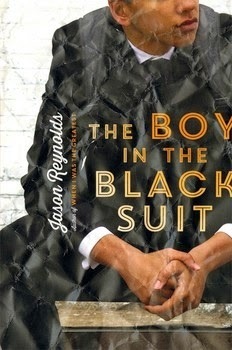 Jason Reynolds's sophomore novel, The Boy in the Black Suit, takes what he did great in his first book and makes it sing even louder.
Jason Reynolds's sophomore novel, The Boy in the Black Suit, takes what he did great in his first book and makes it sing even louder.
After Matt's mother dies, he finds himself looking for a job or an internship. He's going to school part-time in order to gain work experience in those afternoons. It's a way for him to escape his father's own spiraling grief and challenges.
When Matt arrives at the local greasy, fast food chicken joint, he's prepared for the work, even if it's not something that interests him in the least -- and even if it means dealing with obnoxious, rude customers, as he witnesses when he's there filling out the application.
But when an offer to work at a local funeral home comes his way, he can't pass it up, even if he's hesitant to be working in a world of grief close to his own. It's through witnessing those funerals, though, and seeing how other people process their losses, that Matt is better able to process his own.
It's at one of the funerals, though, where Matt stumbles across Lovey. She looks familiar, and he realizes that's because she's the girl who he saw at the fast food joint when he went to apply who had been dealing with rowdy customers. Soon, the two of them begin talking, then spending time together, then finding themselves falling for one another.
Reynolds's story is a quieter one, featuring the kind of character we don't see enough of in YA: a realistic black boy who -- while living in a tough part of Brooklyn and dealing with family and friends who aren't always making smart choices -- is himself intelligent, hard-working, and builds solid relationships with his friends, with his boss at work, and ultimately, Lovey. He isn't stereotyped in any way, and he's also not rendered as a boy who is all feelings, even though he has plenty of them. Rather, he's fully fleshed, dynamic, and his story has a fulfilling arc. It's hopeful, but it's also imperfect. There's exceptional compassion extended to Matt, and there's exceptional compassion extended from him, too.
What stood out to me in this story was the way the relationship between Matt and Lovey grew. This is a sweet and realistic romance, one that's tentative at times, and it's one that's not immediately nor easily rewarded. Since both are working through personal grief and change, it's hard for them to be emotionally available to one another, even when they want to be that way. This is a slow-build and satisfying storyline, which begs readers to root for both characters and their successes alone and together.
The funeral home job element made this story unique, as did its gritty, urban setting. The juxtaposition is, at times, uncomfortable. But that's purposeful, and it makes Matt's voice and perspective shine even stronger. This is a quick read, despite being a quieter one. Hand The Boy in the Black Suit to readers looking for urban-set fiction, for those seeking a nice male-led romance or male-led story about grief and loss, or those looking for something "different" in realistic YA fiction -- this isn't the go-to pick for those who love the best-selling titles. Readers interested in an intergenerational relationship will appreciate Matt and his boss's connections, and those looking for a good male friendship story will appreciate Matt and Chris's relationship, too.
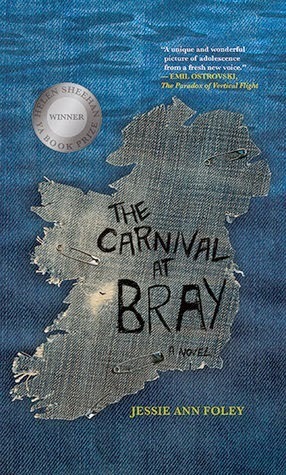 Jessie Ann Foley's The Carnival at Bray had the set up of everything I dislike: a 90s setting that served the purpose of being so for the grunge music and to avoid the social media/mobile phone reality of today.
Jessie Ann Foley's The Carnival at Bray had the set up of everything I dislike: a 90s setting that served the purpose of being so for the grunge music and to avoid the social media/mobile phone reality of today.
But I loved it.
When Maggie's mother remarried Colm, they -- along with her younger sister Ronnie -- move to Bray, a small area on the Eastern shore or Ireland. It's a lonely time in a new place for Maggie, but she's buoyed by her uncle Kevin's letters and packages, as well as by the boy she's run into who she can't keep her eyes off of, even if she has no idea who he is or what he's about. For a short time, Maggie keeps herself occupied with her new friend Aine, but it's not a great friendship. Aine has little interest in Maggie as a person, but in Maggie as a way to spend time with her boyfriend Paddy.
But when Kevin dies unexpectedly, Maggie has to reassess her life as it is and figure out how to make a life in the place she's been planted best she can. There is an adventure to be had, though, when Maggie discovers a letter her mom has hidden from her, where her uncle Kevin has left her a pair of tickets to see Nirvana in Italy, telling her to take the boy with her. Maggie hems and haws about it, being a good girl like she is, but then she and Eoin take the adventure. It costs them both deeply.
What was great: this wasn't about the music as portrayed in the book. It was about the power of music, period. It was about fulfilling that dream of seeing a band you love and being part of a crowd of other people who are sharing an experience with you, but not necessarily sharing the exact same experience you are. It's about friendship and about the challenges of meeting new people and learning to trust their intentions. It's about romance and finding someone who gets you, through thick and thin. It's, even more, about family. The relationship between Maggie and her mother is rendered so well and so painfully, and the relationship between Maggie and her sister Ronnie is so a relationship between a 16-year-old girl and her 11-year-old sister. But more, it was the Kevin-Maggie relationship I loved most.
Foley's use of setting is really great, and the use of third person was surprising and perfect for this story. The writing itself was smooth, and in the first sex scene of the book -- not one between Maggie and Eoin, but Maggie and another boy -- it was awkward and written in an honest manner that handled it better than many first-person narratives do. But this isn't a book where sex matters much. Rather, what makes it good is the longing we get from Maggie and how much she yearns and craves something physical from Eoin, and he doesn't press her for it. Instead, we see intimacy -- they shared a bed, fully clothed, and it's that which Maggie lets linger and sustain her through the separation they have.
This isn't a big story -- Kevin's death and subsequent understanding of why and how he died isn't a huge part of the book -- and it reads quickly, but there's a lot of story packed in here. This is a story about love and loss, about learning how to make a life and a living when everything that had been a part of your life is torn away, by forces you can never understand. It's about choices other people make and how deeply they impact you personally.
I'd avoided picking this one up because of the time period setting, even after it was named a Morris finalist. The 90s setting is a convenience in the story; there's no way that Maggie would have gotten away with a cross-continental trip in the same way with modern technology, and there's no way the final moments of the story, which happen at a concert after Kurt Cobain's death was announced, would have happened, either. Fortunately, these conveniences for the purpose of plot weren't distracting and didn't overshadow the strengths of the story or of the voice. I suspect most readers won't be paying attention to those workarounds.
Hand The Carnival at Bray to readers who love foreign settings, as well as those who like a story set in another era. This is the kind of book that fans of Melina Marchetta will dig, especially for how it portrays the complexities of family relationships. There's an excellent intergenerational relationship between Maggie and an older man in Bray, and there's an interesting -- and surprisingly refreshing -- religious school that plays a notable part in the story.






 Related StoriesOn The Radar: 12 YA Books for JanuaryA Few Cybils Reads - Part XA Few Cybils Reads - Part IX (Time Travel Edition)
Related StoriesOn The Radar: 12 YA Books for JanuaryA Few Cybils Reads - Part XA Few Cybils Reads - Part IX (Time Travel Edition)
These are also both titles that do one of my favorite things in realistic fiction: they showcase how you can bloom where you're planted when the choice of where you are is outside your control.
 Jason Reynolds's sophomore novel, The Boy in the Black Suit, takes what he did great in his first book and makes it sing even louder.
Jason Reynolds's sophomore novel, The Boy in the Black Suit, takes what he did great in his first book and makes it sing even louder.After Matt's mother dies, he finds himself looking for a job or an internship. He's going to school part-time in order to gain work experience in those afternoons. It's a way for him to escape his father's own spiraling grief and challenges.
When Matt arrives at the local greasy, fast food chicken joint, he's prepared for the work, even if it's not something that interests him in the least -- and even if it means dealing with obnoxious, rude customers, as he witnesses when he's there filling out the application.
But when an offer to work at a local funeral home comes his way, he can't pass it up, even if he's hesitant to be working in a world of grief close to his own. It's through witnessing those funerals, though, and seeing how other people process their losses, that Matt is better able to process his own.
It's at one of the funerals, though, where Matt stumbles across Lovey. She looks familiar, and he realizes that's because she's the girl who he saw at the fast food joint when he went to apply who had been dealing with rowdy customers. Soon, the two of them begin talking, then spending time together, then finding themselves falling for one another.
Reynolds's story is a quieter one, featuring the kind of character we don't see enough of in YA: a realistic black boy who -- while living in a tough part of Brooklyn and dealing with family and friends who aren't always making smart choices -- is himself intelligent, hard-working, and builds solid relationships with his friends, with his boss at work, and ultimately, Lovey. He isn't stereotyped in any way, and he's also not rendered as a boy who is all feelings, even though he has plenty of them. Rather, he's fully fleshed, dynamic, and his story has a fulfilling arc. It's hopeful, but it's also imperfect. There's exceptional compassion extended to Matt, and there's exceptional compassion extended from him, too.
What stood out to me in this story was the way the relationship between Matt and Lovey grew. This is a sweet and realistic romance, one that's tentative at times, and it's one that's not immediately nor easily rewarded. Since both are working through personal grief and change, it's hard for them to be emotionally available to one another, even when they want to be that way. This is a slow-build and satisfying storyline, which begs readers to root for both characters and their successes alone and together.
The funeral home job element made this story unique, as did its gritty, urban setting. The juxtaposition is, at times, uncomfortable. But that's purposeful, and it makes Matt's voice and perspective shine even stronger. This is a quick read, despite being a quieter one. Hand The Boy in the Black Suit to readers looking for urban-set fiction, for those seeking a nice male-led romance or male-led story about grief and loss, or those looking for something "different" in realistic YA fiction -- this isn't the go-to pick for those who love the best-selling titles. Readers interested in an intergenerational relationship will appreciate Matt and his boss's connections, and those looking for a good male friendship story will appreciate Matt and Chris's relationship, too.
 Jessie Ann Foley's The Carnival at Bray had the set up of everything I dislike: a 90s setting that served the purpose of being so for the grunge music and to avoid the social media/mobile phone reality of today.
Jessie Ann Foley's The Carnival at Bray had the set up of everything I dislike: a 90s setting that served the purpose of being so for the grunge music and to avoid the social media/mobile phone reality of today. But I loved it.
When Maggie's mother remarried Colm, they -- along with her younger sister Ronnie -- move to Bray, a small area on the Eastern shore or Ireland. It's a lonely time in a new place for Maggie, but she's buoyed by her uncle Kevin's letters and packages, as well as by the boy she's run into who she can't keep her eyes off of, even if she has no idea who he is or what he's about. For a short time, Maggie keeps herself occupied with her new friend Aine, but it's not a great friendship. Aine has little interest in Maggie as a person, but in Maggie as a way to spend time with her boyfriend Paddy.
But when Kevin dies unexpectedly, Maggie has to reassess her life as it is and figure out how to make a life in the place she's been planted best she can. There is an adventure to be had, though, when Maggie discovers a letter her mom has hidden from her, where her uncle Kevin has left her a pair of tickets to see Nirvana in Italy, telling her to take the boy with her. Maggie hems and haws about it, being a good girl like she is, but then she and Eoin take the adventure. It costs them both deeply.
What was great: this wasn't about the music as portrayed in the book. It was about the power of music, period. It was about fulfilling that dream of seeing a band you love and being part of a crowd of other people who are sharing an experience with you, but not necessarily sharing the exact same experience you are. It's about friendship and about the challenges of meeting new people and learning to trust their intentions. It's about romance and finding someone who gets you, through thick and thin. It's, even more, about family. The relationship between Maggie and her mother is rendered so well and so painfully, and the relationship between Maggie and her sister Ronnie is so a relationship between a 16-year-old girl and her 11-year-old sister. But more, it was the Kevin-Maggie relationship I loved most.
Foley's use of setting is really great, and the use of third person was surprising and perfect for this story. The writing itself was smooth, and in the first sex scene of the book -- not one between Maggie and Eoin, but Maggie and another boy -- it was awkward and written in an honest manner that handled it better than many first-person narratives do. But this isn't a book where sex matters much. Rather, what makes it good is the longing we get from Maggie and how much she yearns and craves something physical from Eoin, and he doesn't press her for it. Instead, we see intimacy -- they shared a bed, fully clothed, and it's that which Maggie lets linger and sustain her through the separation they have.
This isn't a big story -- Kevin's death and subsequent understanding of why and how he died isn't a huge part of the book -- and it reads quickly, but there's a lot of story packed in here. This is a story about love and loss, about learning how to make a life and a living when everything that had been a part of your life is torn away, by forces you can never understand. It's about choices other people make and how deeply they impact you personally.
I'd avoided picking this one up because of the time period setting, even after it was named a Morris finalist. The 90s setting is a convenience in the story; there's no way that Maggie would have gotten away with a cross-continental trip in the same way with modern technology, and there's no way the final moments of the story, which happen at a concert after Kurt Cobain's death was announced, would have happened, either. Fortunately, these conveniences for the purpose of plot weren't distracting and didn't overshadow the strengths of the story or of the voice. I suspect most readers won't be paying attention to those workarounds.
Hand The Carnival at Bray to readers who love foreign settings, as well as those who like a story set in another era. This is the kind of book that fans of Melina Marchetta will dig, especially for how it portrays the complexities of family relationships. There's an excellent intergenerational relationship between Maggie and an older man in Bray, and there's an interesting -- and surprisingly refreshing -- religious school that plays a notable part in the story.







 Related StoriesOn The Radar: 12 YA Books for JanuaryA Few Cybils Reads - Part XA Few Cybils Reads - Part IX (Time Travel Edition)
Related StoriesOn The Radar: 12 YA Books for JanuaryA Few Cybils Reads - Part XA Few Cybils Reads - Part IX (Time Travel Edition)
Published on January 11, 2015 22:00
January 10, 2015
This Week in Reading, Volume 11

It's been more than a month since I did a "This Week in Reading. In the interest of getting to what I really want to do -- share a pile of links from around the web -- I'm limiting the books I've received to just things this week. I went on a little bit of a buying spree at the end of the year, and I hit up the library for a bunch of things that got added to my "to read" list. All links go to Goodreads.
From the library:
A Cup of Water Under My Bed by Daisy Hernandez -- I'm most of the way done with this and really enjoying this memoir of growing up in a Colombian-Cuban household and being bisexual. The way she talks about intersections and about divergencies in culture are fascinating.
A Time to Dance by Padma Venkatraman
Boy, Snow, Bird by Helen Oyeyemi
Men We Reaped by Jesmyn Ward
For review:
The Tragic Age by Stephen Metcalfe
Tunnel Vision by Susan Adrian
Purchased:
I think my "getting it together" and "getting organized" and "being super productive" kicks are evident here.
The Winter People by Jennifer McMahon
The Power of Habit by Charles Duhigg -- My husband raves about this book. Then the cat ate our copy. So, a new one so I can read it.
The Checklist Manifesto by Atul Gawande
The Cranes Dance by Meg Howrey
Listful Thinking by Paula Rizzo
Around the Web:
There's been so much good stuff piling up in my bookmarks. Enjoy!
This isn't about books or blogging, but it's about careers, the arts, writing, and feminism. This interview with Carrie Brownstein reminds me why I love her so much and it's a really inspiring piece about making and having a creative life.
Along with some other librarians and YA enthusiasts, I helped build a feminist YA romances list, as requested by Jessica Luther. She posted it up on her blog. While we're on feminism, Feminista Jones tweeted out and rounded up a pile of books to read to educate yourself on Black Feminism.
Molly Wetta and Dahlia both put together resource lists on upcoming LGBTQIA YA novels. Libertad Araceli Thomas wrote about being a Black Latino that is really, really worth reading.
Rin Chupecho's Smugglivus guest post about "strong female characters" goes places where that phrase normally doesn't go, and it's awesome.
If you missed it, the Cybils finalists were announced. Winners will be announced on Valentine's Day.







 Related StoriesThis Week in Reading: Volume XThis Week in Reading: Volume IXThis Week in Reading: Volume VIII
Related StoriesThis Week in Reading: Volume XThis Week in Reading: Volume IXThis Week in Reading: Volume VIII
Published on January 10, 2015 22:00
January 8, 2015
This Week at Book Riot
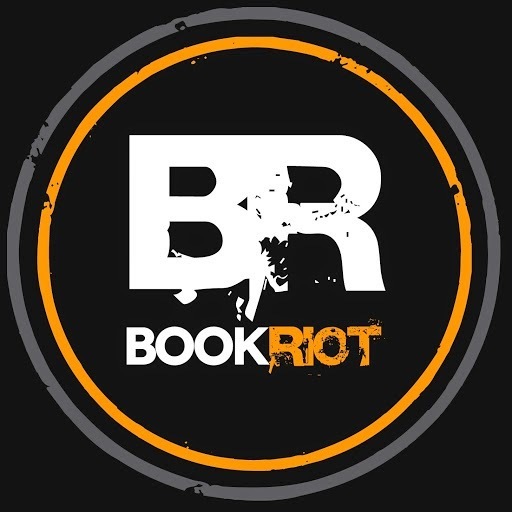
This week over at Book Riot, I wrote a few things:
Here's the big, huge, not-little-at-all preview of YA books coming out between January and March. I'm doing these round-ups quarterly, so I can have more depth and variety. This week's "3 On A YA Theme" covers 3 non-fiction titles and 3 fiction titles featuring trans* teen experiences and lives. I wrote about the best of bookish Portlandia, one of my favorite shows, featuring one of my favorite leading ladies, Carrie Brownstein.
Also on Book Riot, I talked about my favorite book of December in our monthly Roit Round-up, which was Melanie Crowder's Audacity:

And finally, the Book Riot Podcast announced that there will be a Quarterly YA Box, with subscriptions opening in February and first boxes shipping in April. More info soon, but I'm getting to curate it and I am very excited.







 Related StoriesThis Week Around The WebThis Week at Book RiotThis Week on Book Riot & The Book Smugglers
Related StoriesThis Week Around The WebThis Week at Book RiotThis Week on Book Riot & The Book Smugglers
Published on January 08, 2015 22:00
January 7, 2015
Get Genrefied: YA Memoirs

While we've been putting together our monthly "get genrefied" guides over the last two years, it's been neat to see what trends in publishing have emerged and which have subsided a bit. Without doubt, one of the biggest trends in the last two years is one which we aren't as familiar with and one we don't talk much about: young adult non-fiction. The growth in YA non-fiction can, of course, be partially attributed to the implementation of Common Core. But it's also worth noting that because YA non-fiction has gotten so great in the last few years that more and more of it has been published.
One subsection within YA non-fiction that has seen tremendous growth in the last few years is the YA memoir. These are written for teens, about an experience by the author in their teens, regardless of whether or not they're in their teens as they're writing or it they're adults reflecting upon a teen experience. Though it's arguable whether or not memoirs are a genre per se, let's dig into this category of YA.
Definition and History
What's a "memoir" and how does it differ from "autobiography?"
This isn't a dumb question at all, and it's one that people are often confused about because the terms are often used interchangeably. Even major retailers lump the two together, even though they're not the same thing.
Memoir, by definition, covers a specific period of time or experience within a person's life. An autobiography, on the other hand, covers an entire lifespan. Wikipedia actually puts it most succinctly, noting that autobiographies are of a life while memoirs are from a life. Both of these differ from biography, which is a story of someone's life as told by a third party.
Memoirs have huge appeal for teen readers and they always have. Anyone who has worked in a library knows that books like Dave Pelzer's A Child Called It is perennially popular with teen readers, especially among younger teens. Other memoirs, like Ishmael Beah's A Long Way Gone and Jeannette Walls's The Glass Castle, are popular among teen readers and are frequently on reading lists in classrooms or for enrichment. There is something appealing about reading someone's true story, and while these three books, along with many other sought-after memoirs, are published as adult non-fiction, they have tremendous crossover appeal. But with the explosion of memoirs geared directly toward teen readers in the last few years, the options for what teens can pick up and relate to continue to get better and better.
Very little has been written about YA memoirs specifically, likely because it's become an emerging category of YA non-fiction, rather than something that's always been specifically geared toward those readers. It's not just adult books that are being rewritten and adapted for a teen audience (which we've written about before), but it's a category all its own.
Taking a look back at the memoirs written for teens in the early 2000s, it's interesting to see that the bulk -- and those which have remained around -- were written by well-known and popular young adult authors. Walter Dean Myers, Ned Vizzini, Jack Gantos, and Chris Crutcher all wrote YA memoirs: Bad Boy, Teen Angst? Naaah..., Hole in My Life, and King of the Mild Frontier respectively. More recently, though, it's new voices that are lending their stories to YA audiences. These are authors who don't already have a foot in the category or who may otherwise not be known to teen readers at all.
Resources
Since YA memoirs are an emerging category within YA non-fiction, there aren't many resources available. Seeking these books out isn't the easiest, as YA non-fiction has itself been difficult to seek out more broadly. As always, Edelweiss proves to be one of the best resources, though it's also one of the most time-consuming: even with good searching, finding the non-fiction for teens can be challenging.
With the change in YALSA's awards and selection list honors a few years ago, non-fiction become deemphasized. The "Best Fiction for Young Adults" list used to be the "Best Books for Young Adults" list, and it included both fiction and non-fiction; now it's fiction only. Part of the change, of course, was to help guide people toward one of the best resources for finding YA non-fiction: the Excellence in Non-Fiction Award (ENYA). Though it covers the broad range of non-fiction titles published for YA readers, it does and has included memoirs on its lists.
The ENYA isn't the only YALSA resource featuring non-fiction, though. The Quick Picks for Reluctant Readers list also includes non-fiction titles, some of which may include memoirs. Likewise, the Great Graphic Novels list includes non-fiction, too. Since memoirs can be rendered in comic form, this is a really valuable resource for finding those titles. Of course, non-fiction of any flavor is as eligible for the Printz award and the Morris award as fiction.
Beyond those lists and the use of Edelweiss, there aren't many resources available for finding YA non-fiction and even fewer for YA memoirs. Perusing the awards of other organizations, it's interesting to see that YA non-fiction isn't even a category in some cases. For example, the International Reading Association designates awards for primary non-fiction and intermediate non-fiction, but they limit their YA honors to fiction only. Perhaps as non-fiction becomes more pervasive in YA -- and again, its growth has been remarkable in the last two to three years alone -- more acknowledgement and more tools will become available for finding high quality stories and matching them with teen readers.
Books
Because trying to include crossover titles in this list would make it really long, I'm sticking (mostly) to memoirs that were published for a YA readership. I've limited the list further to those titles out in the last 5-7 years, as well as forthcoming titles worth having on your radar now. As always, descriptions come from WorldCat, and any other additions are welcome in the comments. These are all memoirs, as opposed to autobiographies. In some cases, there's not an easy distinction or it becomes blurred and fuzzy (as in the Earl title), but I've included it here anyway.
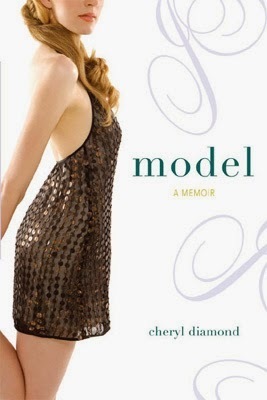

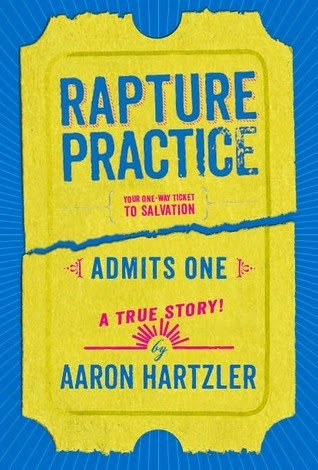
Model by Cheryl Diamond: Presents the true story of one teen's attempt to break into New York's modeling industry at the age of fourteen, where a career-altering event changed her life and nearly ruined her shot at her dream.
Positive by Paige Rawl A teenager's memoir of the experinces of bullying, being HIV positive and surviving the experiences to become a force for positive change in this world.
Rapture Practice by Aaron Hartzler: Aaron Hartzler grew up in a home where he was taught that at any moment the Rapture could happen -- that Jesus might come down in the twinkling of an eye and scoop Aaron and his whole family up to Heaven. As a kid, he was thrilled by the idea that every moment of every day might be his last one on Earth. But as Aaron turns sixteen, he finds himself more attached to his earthly life and curious about all the things his family forsakes for the Lord. He begins to realize he doesn't want the Rapture to happen just yet -- not before he sees his first movie, stars in the school play, or has his first kiss. Eventually Aaron makes the plunge from conflicted do-gooder to full-fledged teen rebel. Whether he's sneaking out, making out, or playing hymns with a hangover, Aaron learns a few lessons that can't be found in the Bible. He discovers that the best friends aren't always the ones your mom and dad approve of, the girl of your dreams can just as easily be the boy of your dreams, and the tricky part about believing is that no one can do it for you. In this coming-of-age memoir, Hartzler recalls his teenage journey to become the person he wanted to be, without hurting the family that loved him.
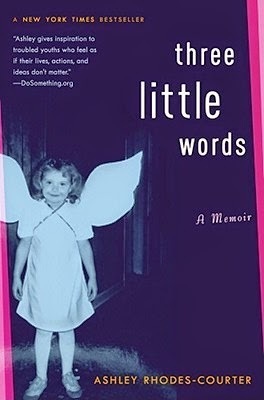

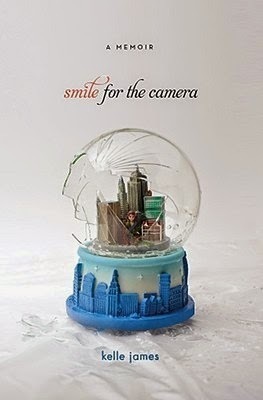
Three Little Words by Ashley Rhodes-Courter: Ashley spent nine years in foster care after being taken away from her mother. She endured many caseworkers, moving from school to school and manipulative, humiliating and abusive treatment from one foster family. See how she survives and eventually thrives against the odds.
Three More Words by Ashley Rhodes-Courter (May 5): In the sequel to the New York Times bestselling memoir Three Little Words, Ashley Rhodes-Courter expands on life beyond the foster care system, the joys and heartbreak with a family she's created, and her efforts to make peace with her past. (Description via Goodreads)
Smile for the Camera by Kelle James: The author relates her experiences after she left an abusive home at sixteen and traveled to New York City to pursue a career as a model.

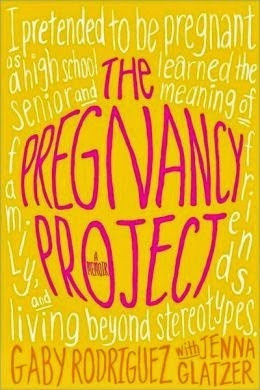
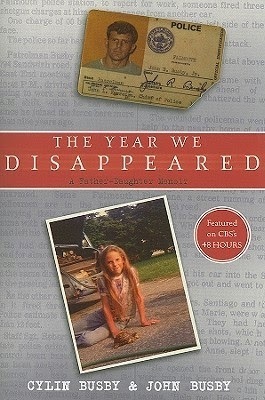
Rock 'N Roll Soldier by Dean Ellis Kohler: Dean Ellis Kohler, aspiring rock star, is drafted and sent to Vietnam, where he forms a rock 'n' roll band at the behest of his Captain.
The Pregnancy Project by Gaby Rodriguez: In this book, Rodriguez shares her experience growing up in the shadow of low expectations, reveals how she was able to fake her own pregnancy, and reveals all that she learned from the experience. But more than that, Gaby's story is about fighting stereotypes, and how one girl found the strength to come out from the shadow of low expectations to forge a bright future for herself.
The Year We Disappeared by Cylin Busby and John Busby: Cylin and John Busby share the challenges they faced after their family was forced into hiding to protect themselves from a killer who had already shot John, a police officer, and was determined to finish the job.
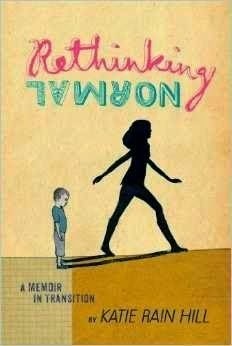
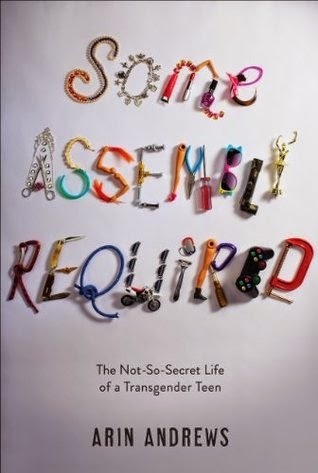

Rethinking Normal by Katie Rain Hill: In her unique, generous, and affecting voice, nineteen-year-old Katie Hill shares her personal journey of undergoing gender reassignment. Have you ever worried that you'd never be able to live up to your parents' expectations? Have you ever imagined that life would be better if you were just invisible? Have you ever thought you would do anything--anything--to make the teasing stop? Katie Hill had and it nearly tore her apart. Katie never felt comfortable in her own skin. She realized very young that a serious mistake had been made; she was a girl who had been born in the body of a boy. Suffocating under her peers' bullying and the mounting pressure to be "normal," Katie tried to take her life at the age of eight years old. After several other failed attempts, she finally understood that "Katie"--the girl trapped within her--was determined to live. In this first-person account, Katie reflects on her pain-filled childhood and the events leading up to the life-changing decision to undergo gender reassignment as a teenager. She reveals the unique challenges she faced while unlearning how to be a boy and shares what it was like to navigate the dating world and experience heartbreak for the first time in a body that matched her gender identity. Told in an unwaveringly honest voice, Rethinking Normal is a coming-of-age story about transcending physical appearances and redefining the parameters of "normalcy" to embody one's true self.
Some Assembly Required by Arin Andrews: Seventeen-year-old Arin Andrews shares all the hilarious, painful, and poignant details of undergoing gender reassignment as a high school student in this winning teen memoir
The Boy on the Wooden Box by Leon Leyson: The biography of Leon Leyson, the only memoir published by a former Schindler's List child.


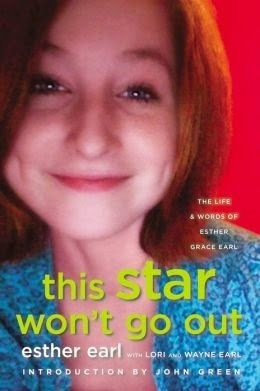
I Am Malala by Malala Yousafzai: I Am Malala. This is my story. Malala Yousafzai was only ten years old when the Taliban took control of her region. They said music was a crime. They said women weren't allowed to go to the market. They said girls couldn't go to school. Raised in a once-peaceful area of Pakistan transformed by terrorism, Malala was taught to stand up for what she believes. So she fought for her right to be educated. And on October 9, 2012, she nearly lost her life for the cause: She was shot point-blank while riding the bus on her way home from school. No one expected her to survive. Now Malala is an international symbol of peaceful protest and the youngest ever Nobel Peace Prize nominee. In this Young Readers Edition of her bestselling memoir, which includes exclusive photos and material, we hear firsthand the remarkable story of a girl who knew from a young age that she wanted to change the world -- and did. Malala's powerful story will open your eyes to another world and will make you believe in hope, truth, miracles and the possibility that one person -- one young person -- can inspire change in her community and beyond.
Laughing at My Nightmare by Shane Burcaw: With acerbic wit ... Shane Burcaw describes the challenges he faces as a twenty-one-year-old with spinal muscular atrophy. From awkward handshakes to having a girlfriend and everything in between, Shane handles his situation with humor and a 'you-only-live-once' perspective on life. While he does talk about everyday issues that are relatable to teens, he also offers an eye-opening perspective on what it is like to have a life-threatening disease.
This Star Won't Go Out by Esther Earl: A memoir told through the journals, letters, and stories of young cancer patient Esther Earl.
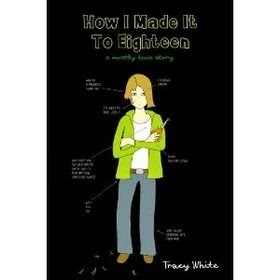


Little Fish by Ramsey Beyer: Written in an autobiographical style with artwork, this book shows the challenges of being a young person facing the world on your own for the very first time and the unease - as well as excitement - that comes along with that challenge. (This WorldCat description is not good -- this is a memoir that mixes narrative with lists, ephemera, and art).
Tomboy by Liz Prince: Eschewing female stereotypes throughout her early years and failing to gain acceptance on the boys' baseball team, Liz learns to embrace her own views on gender as she comes of age, in an anecdotal graphic novel memoir.
How I Made it to Eighteen (A Mostly True Story) by Tracey White: How do you know if you're on the verge of a nervous breakdown? For seventeen-year-old Stacy Black, it all begins with the smashing of a window. After putting her fist through the glass, she checks into a mental hospital. Stacy hates it there but despite herself slowly realizes she has to face the reasons for her depression to stop from self-destructing. Based on the author's experiences, How I Made it to Eighteen is a frank portrait of what it's like to struggle with self-esteem, body image issues, drug addiction, and anxiety.
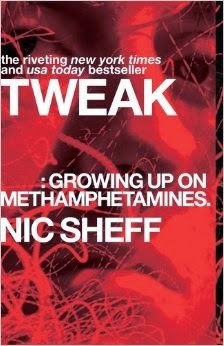

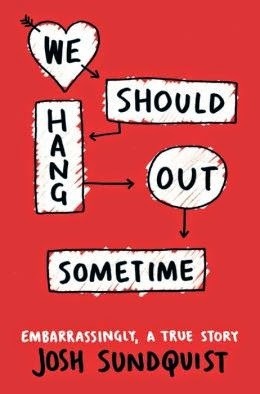
Tweak by Nic Sheff: The author details his immersion in a world of hardcore drugs, revealing the mental and physical depths of addiction, and the violent relapse one summer in California that forever changed his life, leading him down the road to recovery.
We All Fall Down by Nic Sheff: Sheff writes candidly about stints at in-patient rehab facilities, devastating relapses, and hard-won realizations about what it means to be a young person living with addiction.
We Should Hang Out Sometime by Josh Sundquist: Why was [Paralympic ski racer and cancer survivor] Josh still single? To find out, he tracked down the girls he had tried to date and asked them straight up: what went wrong? The results of Josh's semiscientific, wholly hilarious investigation are captured here: disastrous Putt-Putt date involving a backward prosthetic foot, to his introduction to CFD (Close Fast Dancing), to a misguided 'grand gesture' at a Miss America pageant, this story is about looking for love--or at least a girlfriend--in all the wrong places.
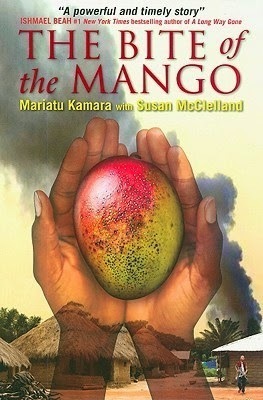
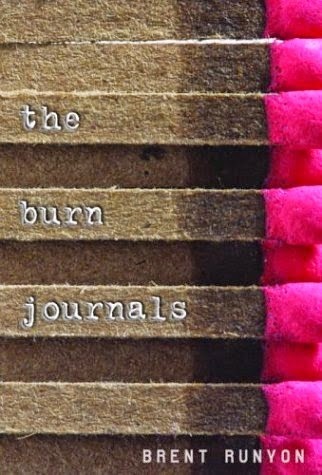
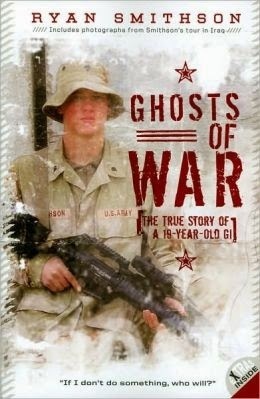
The Bite of Mango by Mariatu Kamara: When Mariatu set out for a neighborhood village in Sierra Leone, she was kidnapped and tortured, and both of her hands cut off. She turned to begging to survive. This heart-rending memoir is a testament to her courage and resilience. Today she is a UNICEF Special Representative for Children and Armed Conflict.
The Burn Journals by Brent Runyon: Brent Runyon was fourteen years old when he set himself on fire. In this book he describes that suicide attempt and his recovery over the following year. He takes us into the Burn Unit in a children₂s hospital and through painful burn care and skin-grafting procedures. Then to a rehabilitation hospital, for intensive physical, occupational, and psychological therapy. And then finally back home, to the frightening prospect of entering high school. But more importantly, Runyon takes us into his own mind. He shares his thoughts and hopes and fears with such unflinching honesty that we understand₇with a terrible clarity₇what it means to want to kill yourself and how it feels to struggle back toward normality. Intense, exposed, insightful, The Burn Journals is a deeply personal story with universal reach. It is impossible to look away. Impossible to remain unmoved.
Ghosts of War by Ryan Smithson: Ryan Smithson joined the Army Reserve when he was seventeen. Two years later, he was deployed to Iraq as an Army engineer. In this extraordinary and harrowing memoir, readers march along one GI's tour of duty. Smithson avoids writing either prowar propaganda or an antimilitary polemic, providing instead a fascinating, often humorous-and occasionally devastating-account of the motivations and life of a contemporary soldier.
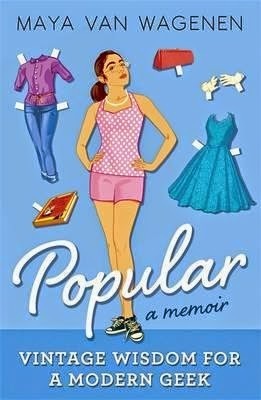
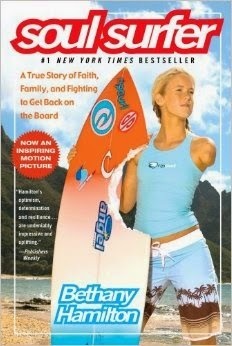
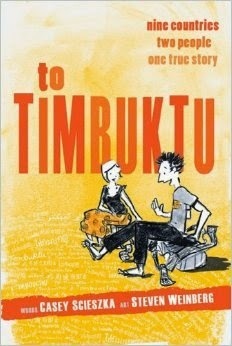
Popular by Maya Van Wagenen: A touchingly honest, candidly hysterical memoir from breakout teen author Maya Van Wagenen. Stuck at the bottom of the social ladder at "pretty much the lowest level of people at school who aren't paid to be here," Maya Van Wagenen decided to begin a unique social experiment: spend the school year following a 1950s popularity guide, written by former teen model Betty Cornell. Can curlers, girdles, Vaseline, and a strand of pearls help Maya on her quest to be popular? The real-life results are painful, funny, and include a wonderful and unexpected surprise-meeting and befriending Betty Cornell herself. Told with humor and grace, Maya's journey offers readers of all ages a thoroughly contemporary example of kindness and self-confidence.
Soul Surfer by Bethany Hamilton: Bethany Hamilton, a teenage surfer lost her arm in a shark attack off the coast of Kauai, Hawaii. Not even the loss of her arm keeps her from returning to surfing, the sport she loves.
To Timbuktu by Casey Scieszka and Steven Weinberg: Casey and Steven met in Morocco, moved to China then went all the way to Timbuktu. This illustrated travel memoir tells the story of their first two years out of college spent teaching English, making friends across language barriers, researching, painting, and learning to be themselves wherever they are.
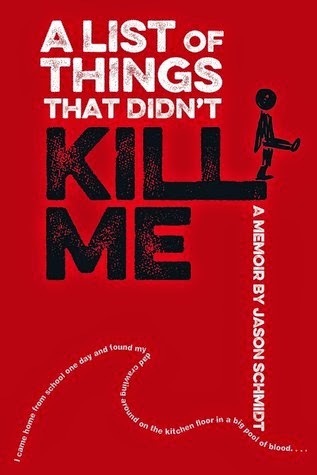
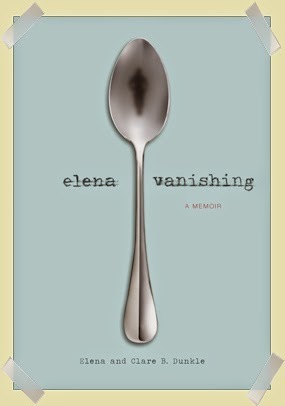

A List of Things That Didn't Kill Me by Jason Schmidt: In his memoir, Jason Kovacs tells the story of growing up with an abusive father, who contracted HIV and ultimately died of AIDS when Jason was a teenager
Elena Vanishing by Elena and Clare B. Dunkle (May 19): Seventeen-year-old Elena is vanishing. Every day means renewed determination, so every day means fewer calories. This is the story of a girl whose armor against anxiety becomes artillery against herself as she battles on both sides of a lose-lose war in a struggle with anorexia. Told entirely from Elena's perspective over a five-year period and co-written with her mother, award-winning author Clare B. Dunkle, Elena's memoir is a fascinating and intimate look at a deadly disease, and a must read for anyone who knows someone suffering from an eating disorder. (Description via Goodreads).
I Will Always Write Back by Caitlin Alifirenka and Martin Ganda (April 14): It started as an assignment. Everyone in Caitlin's class wrote to an unknown student somewhere in a distant place. All the other kids picked countries like France or Germany, but when Caitlin saw Zimbabwe written on the board, it sounded like the most exotic place she had ever heard of--so she chose it.
Martin was lucky to even receive a pen pal letter. There were only ten letters, and forty kids in his class. But he was the top student, so he got the first one.
That letter was the beginning of a correspondence that spanned six years and changed two lives.
In this compelling dual memoir, Caitlin and Martin recount how they became best friends --and better people--through letters. Their story will inspire readers to look beyond their own lives and wonder about the world at large and their place in it. (Description via Goodreads).
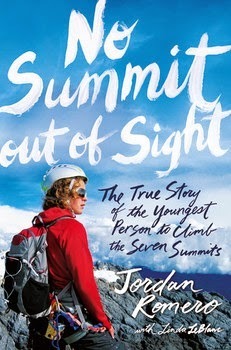

No Summit Out of Sight by Jordan Romero: The story of Jordan Romero, who at the age of 13 became the youngest person ever to reach the summit of Mount Everest. At age 15, he reached the summits of the world's 7 highest mountains.
Hidden Girl by Shyima Hall The author, Shyima Hall, was eight when her parents sold her into slavery. In Egypt's capitol city of Cairo, she lived with a wealthy family and serve them eighteen hours a day, seven days a week. When she was ten, her captors moved to Orange County, California, and smuggled Shyima with them. Two years later, an anonymous call from a neighbor brought about the end of Shyima's servitude-- but her journey to true freedom was far from over. Now a US citizen, she regularly speaks out about human trafficking and candidly reveals how she overcame her harrowing circumstances.







 Related StoriesAncient Historical YAGet Genrefied: Christian FictionCybils Wrap-Up: Stats and the Ones That Got Away
Related StoriesAncient Historical YAGet Genrefied: Christian FictionCybils Wrap-Up: Stats and the Ones That Got Away
Published on January 07, 2015 22:00
January 6, 2015
Ancient Historical YA
After my Cybils reading ended, I figured I'd end up diving into a bunch of adult romances as a palate cleanser. I felt like I needed something different, and adult romances are pretty different from YA SFF. Instead, I found myself reaching for a bunch of YA historicals - books about girls trying to make lives for themselves when their choices were pretty limited.
I grabbed one in particular ( Forbidden by Kimberley Griffiths Little) because it's about a time and place I haven't read much of: ancient Mesopotamia. YA historicals set in BCE times tend to focus on Egypt, Rome, or Greece, and while I like those well enough, I'm always eager for books about places I know less about. Teens who love historical fiction are hungry for stories about new and faraway places. There are only so many books you can read about a certain place before it doesn't seem all that interesting anymore.
For this post, I really wanted to create a nice, medium-sized booklist of recent ancient YA historicals set in places like the Middle East, Asia, and Africa (excluding Egypt). I thought it would be useful for our readers as well as for me, since I'm always seeking out new books like this to read. I quickly realized this was a more difficult task than I initially thought. There just aren't that many.
For the purposes of the list, I defined ancient history as Wikipedia does: from the beginning of recorded history to the start of the Middle Ages. In years, this is roughly 3000 BCE to 500 CE. It's a huge span of time and it's such a disappointment that so much of what's being published is focused so exclusively on three specific places. There's more to be found once we enter the Middle Ages, from more parts of the world, but if you're looking to branch out in true ancient history, you're almost entirely out of luck. (Many of the stories set in the ancient Middle East are Biblical as well, and those are certainly valid stories, but they shouldn't be the only ones.)
I listed the few I've found below. These are all published within the last decade, take place between the years mentioned above, and are set primarily in places other than Egypt, Greece, or Rome. If you know of any others, please let me know!
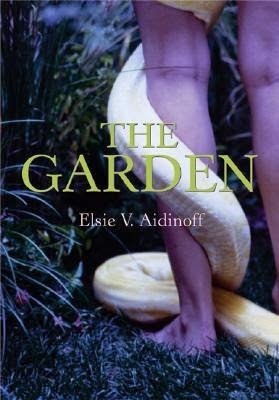
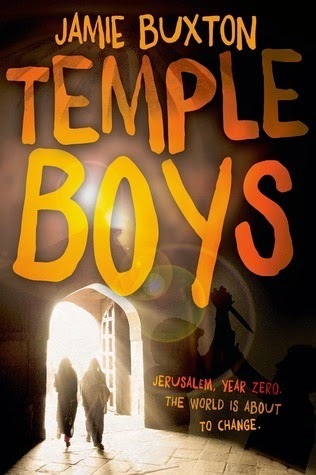
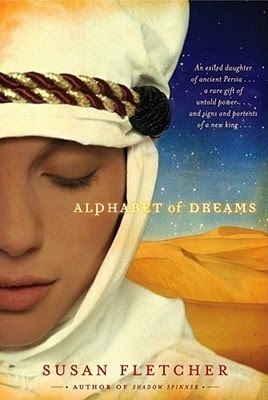
The Garden by Elsie V. Aidinoff
Retells the tale of the Garden of Eden from Eve's point of view, as Serpent teaches her everything from her own name to why she should eat the forbidden fruit, and then leaves her with Adam and the knowledge that her choice has made mankind free.
Temple Boys by Jamie Buxton
Jerusalem, year zero. Flea belongs to a gang of teenage vagrants living in the shadow of the Temple, living on their wits and what they can beg or steal. When a man called the Magician arrives, bringing talk of miracles and revolution, Flea and his comrades latch onto the newcomer in the hope that he'll offer them a secure home. As events accumulate and powerful forces gather around the Magician, Flea notices rumblings of discontent among his followers. Is the Magician the savior he claims to be, or a fraud? | Setting: Jerusalem, year zero
Alphabet of Dreams by Susan Fletcher
Fourteen-year-old Mitra, of royal Persian lineage, and her five-year-old brother Babak, whose dreams foretell the future, flee for their lives in the company of the magus Melchoir and two other Zoroastrian priests, traveling through Persia as they follow star signs leading to a newly-born king in Bethlehem. | Setting: Persia, year zero

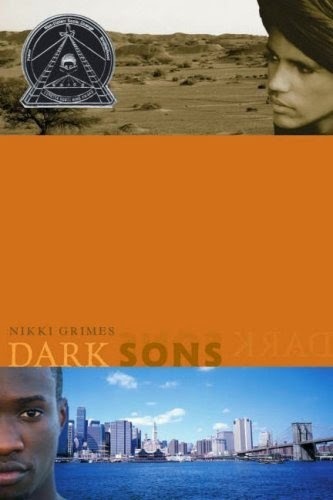
Spirit's Princess by Esther M. Friesner
In ancient Japan, Himiko, the privileged daughter of her clan's leader, fights the constraints and expectations imposed on young women and finds her own path, which includes secret shaman lessons. | Setting: Japan, 3rd century CE
Dark Sons by Nikki Grimes
Alternating poems compare and contrast the conflicted feelings of Ishmael, son of the Biblical patriarch Abraham, and Sam, a teenager in New York City, as they try to come to terms with being abandoned by their fathers and with the love they feel for their younger stepbrothers. | Setting: Present day and Biblical era
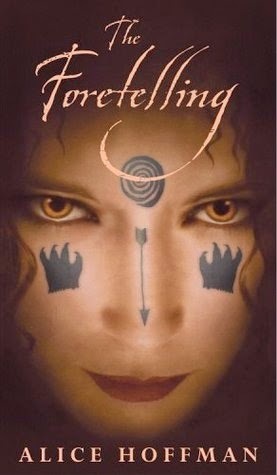
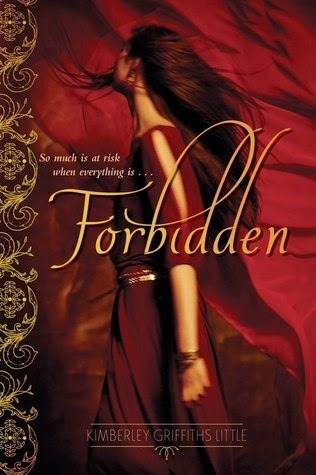
The Foretelling by Alice Hoffman
Growing up the daughter of an Amazon queen who shuns her, Rain rebels against the ways of her tribe through her sister-like relationship with Io and her feelings for a boy from a tribe of wanderers. | Setting: It's nebulous, but probably near the Black Sea
Forbidden by Kimberley Griffiths Little
Devastated by her betrothal to a violent boy she does not love, Jayden is forced to accept her fate as her ancient Mesopotamian tribe moves to the Summer Lands, where she falls for a mysterious youth from the Southern Lands. | Setting: Mesopotamia, 1759 BCE






 Related StoriesGet Genrefied: YA MemoirsCybils Wrap-Up: Stats and the Ones That Got AwayOn The Radar: 12 YA Books for January
Related StoriesGet Genrefied: YA MemoirsCybils Wrap-Up: Stats and the Ones That Got AwayOn The Radar: 12 YA Books for January
I grabbed one in particular ( Forbidden by Kimberley Griffiths Little) because it's about a time and place I haven't read much of: ancient Mesopotamia. YA historicals set in BCE times tend to focus on Egypt, Rome, or Greece, and while I like those well enough, I'm always eager for books about places I know less about. Teens who love historical fiction are hungry for stories about new and faraway places. There are only so many books you can read about a certain place before it doesn't seem all that interesting anymore.
For this post, I really wanted to create a nice, medium-sized booklist of recent ancient YA historicals set in places like the Middle East, Asia, and Africa (excluding Egypt). I thought it would be useful for our readers as well as for me, since I'm always seeking out new books like this to read. I quickly realized this was a more difficult task than I initially thought. There just aren't that many.
For the purposes of the list, I defined ancient history as Wikipedia does: from the beginning of recorded history to the start of the Middle Ages. In years, this is roughly 3000 BCE to 500 CE. It's a huge span of time and it's such a disappointment that so much of what's being published is focused so exclusively on three specific places. There's more to be found once we enter the Middle Ages, from more parts of the world, but if you're looking to branch out in true ancient history, you're almost entirely out of luck. (Many of the stories set in the ancient Middle East are Biblical as well, and those are certainly valid stories, but they shouldn't be the only ones.)
I listed the few I've found below. These are all published within the last decade, take place between the years mentioned above, and are set primarily in places other than Egypt, Greece, or Rome. If you know of any others, please let me know!



The Garden by Elsie V. Aidinoff
Retells the tale of the Garden of Eden from Eve's point of view, as Serpent teaches her everything from her own name to why she should eat the forbidden fruit, and then leaves her with Adam and the knowledge that her choice has made mankind free.
Temple Boys by Jamie Buxton
Jerusalem, year zero. Flea belongs to a gang of teenage vagrants living in the shadow of the Temple, living on their wits and what they can beg or steal. When a man called the Magician arrives, bringing talk of miracles and revolution, Flea and his comrades latch onto the newcomer in the hope that he'll offer them a secure home. As events accumulate and powerful forces gather around the Magician, Flea notices rumblings of discontent among his followers. Is the Magician the savior he claims to be, or a fraud? | Setting: Jerusalem, year zero
Alphabet of Dreams by Susan Fletcher
Fourteen-year-old Mitra, of royal Persian lineage, and her five-year-old brother Babak, whose dreams foretell the future, flee for their lives in the company of the magus Melchoir and two other Zoroastrian priests, traveling through Persia as they follow star signs leading to a newly-born king in Bethlehem. | Setting: Persia, year zero


Spirit's Princess by Esther M. Friesner
In ancient Japan, Himiko, the privileged daughter of her clan's leader, fights the constraints and expectations imposed on young women and finds her own path, which includes secret shaman lessons. | Setting: Japan, 3rd century CE
Dark Sons by Nikki Grimes
Alternating poems compare and contrast the conflicted feelings of Ishmael, son of the Biblical patriarch Abraham, and Sam, a teenager in New York City, as they try to come to terms with being abandoned by their fathers and with the love they feel for their younger stepbrothers. | Setting: Present day and Biblical era


The Foretelling by Alice Hoffman
Growing up the daughter of an Amazon queen who shuns her, Rain rebels against the ways of her tribe through her sister-like relationship with Io and her feelings for a boy from a tribe of wanderers. | Setting: It's nebulous, but probably near the Black Sea
Forbidden by Kimberley Griffiths Little
Devastated by her betrothal to a violent boy she does not love, Jayden is forced to accept her fate as her ancient Mesopotamian tribe moves to the Summer Lands, where she falls for a mysterious youth from the Southern Lands. | Setting: Mesopotamia, 1759 BCE







 Related StoriesGet Genrefied: YA MemoirsCybils Wrap-Up: Stats and the Ones That Got AwayOn The Radar: 12 YA Books for January
Related StoriesGet Genrefied: YA MemoirsCybils Wrap-Up: Stats and the Ones That Got AwayOn The Radar: 12 YA Books for January
Published on January 06, 2015 22:00
January 5, 2015
Cybils Wrap-Up: Stats and the Ones That Got Away
I read 91 books this year as a panelist for Round 1 YA speculative fiction. Out of those 91, I finished 68 and left 23 unfinished. Of those 68 I finished, 21 were books I had read prior to the start of Cybils season. This means I read 47 books in their entirety (and about 25-50 pages of an additional 23 books) in about three months, which works out to a whole book every two days. That's quite a lot of reading!
I love our shortlist for YA speculative fiction this year, and I think it's nearly as perfect as it can get. That said, there were some great reads that I loved but didn't make the cut. I wish we could have put 15 books on the shortlist! Alas, I will comfort myself by blogging about them and telling you why they are fantastic. I hope you'll give them a shot and recommend them to the teens in your life.
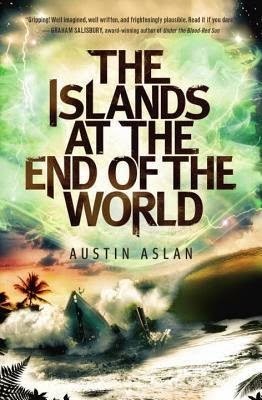
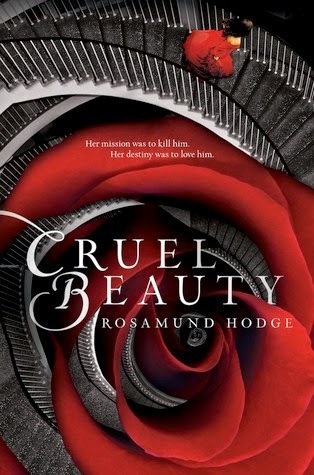
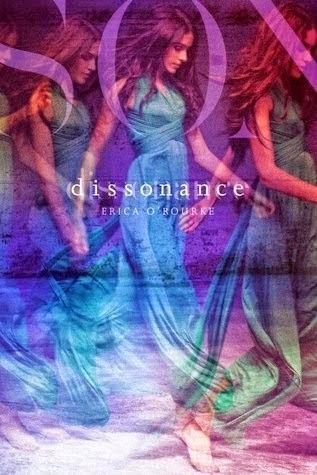
The Islands at the End of the World by Austin Aslan
I loved this story of survival in a worldwide power blackout featuring a teenage girl with epilepsy set on the islands of Hawaii. Leilani is half Native Hawaiian, half white, about to begin a medical study for an epilepsy treatment when the blackout hits. She and her father must try to make it back to the Big Island from Oahu and reunite with the rest of their family amidst the chaos and danger. The first portion of the novel is pure survival, with a few hints at the source of the global catastrophe. Later on, it becomes clear what's causing the blackout, and it's completely unique and very much science fiction. The writing during this portion is particularly lovely and I read it several times over because I loved it so much. There's also a great portrayal of a positive father/daughter relationship that I don't see much of in YA fiction.
Not only is this a fast-paced survival story with a really fresh SF twist, it also features a protagonist of color with deep ties to the environment of Hawaii and her Native Hawaiian culture. Being half-white, half-Native, Leilani often feels caught between two worlds, never belonging completely in either. This crisis allows her to explore that tension and eventually determine that she does have a home and a purpose in Hawaii as she's always wanted. It's obvious Aslan has a great love for Hawaii as a place and for its people and their culture (he is not Native but lived there for some time). There's a solid end to this with room for a sequel, which I very much look forward to reading.
Cruel Beauty by Rosamund Hodge
Intense romance, an often-cruel heroine, a unique re-telling of a beloved fairy tale, and lovely writing all combine to make this debut a complete winner. It's lush and creative and I loved every minute of it. I wrote about it more in February of last year.
Dissonance by Erica O'Rourke
This is a world-building lover's dream with lots of details about parallel/alternate worlds and how Walkers like protagonist Del travel between them. It's also partly a thriller featuring a conspiracy and plenty of flawed characters with secret motivations. It's not a particularly fast read, but it's creative and deep. More here.
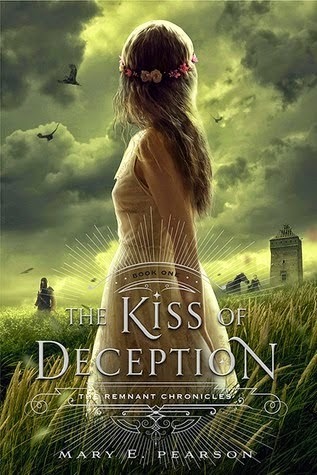
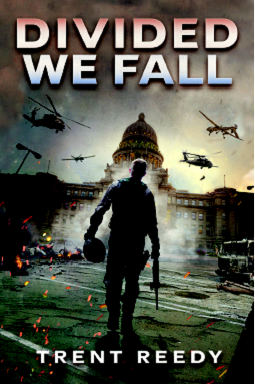
The Kiss of Deception by Mary E. Pearson
Well, you all know this is a book of my heart. It's terrific high fantasy with a spirited heroine who is determined to claim a life of her own. You can read more about my love for it here.
Divided We Fall by Trent Reedy
This is not normally a book I'd pick up my own, but I'm glad I did for the Cybils. It tells of a near future that seems so plausible it's scary (a showdown between the federal government and a state government over a federal ID law that blooms into full-scale civil war). National guardsman Travis is caught in the middle after his gun discharges at a protest. Travis has a great voice; I feel like he exists in so many of today's small-town, semi-rural high schools, and voices like his aren't heard enough in YA fiction. The audio production is one of the best I've ever listened to. More here.






 Related StoriesA Few Cybils Reads - Part XA Few Cybils Reads - Part IX (Time Travel Edition)A Few Cybils Reads - Part VIII
Related StoriesA Few Cybils Reads - Part XA Few Cybils Reads - Part IX (Time Travel Edition)A Few Cybils Reads - Part VIII
I love our shortlist for YA speculative fiction this year, and I think it's nearly as perfect as it can get. That said, there were some great reads that I loved but didn't make the cut. I wish we could have put 15 books on the shortlist! Alas, I will comfort myself by blogging about them and telling you why they are fantastic. I hope you'll give them a shot and recommend them to the teens in your life.



The Islands at the End of the World by Austin Aslan
I loved this story of survival in a worldwide power blackout featuring a teenage girl with epilepsy set on the islands of Hawaii. Leilani is half Native Hawaiian, half white, about to begin a medical study for an epilepsy treatment when the blackout hits. She and her father must try to make it back to the Big Island from Oahu and reunite with the rest of their family amidst the chaos and danger. The first portion of the novel is pure survival, with a few hints at the source of the global catastrophe. Later on, it becomes clear what's causing the blackout, and it's completely unique and very much science fiction. The writing during this portion is particularly lovely and I read it several times over because I loved it so much. There's also a great portrayal of a positive father/daughter relationship that I don't see much of in YA fiction.
Not only is this a fast-paced survival story with a really fresh SF twist, it also features a protagonist of color with deep ties to the environment of Hawaii and her Native Hawaiian culture. Being half-white, half-Native, Leilani often feels caught between two worlds, never belonging completely in either. This crisis allows her to explore that tension and eventually determine that she does have a home and a purpose in Hawaii as she's always wanted. It's obvious Aslan has a great love for Hawaii as a place and for its people and their culture (he is not Native but lived there for some time). There's a solid end to this with room for a sequel, which I very much look forward to reading.
Cruel Beauty by Rosamund Hodge
Intense romance, an often-cruel heroine, a unique re-telling of a beloved fairy tale, and lovely writing all combine to make this debut a complete winner. It's lush and creative and I loved every minute of it. I wrote about it more in February of last year.
Dissonance by Erica O'Rourke
This is a world-building lover's dream with lots of details about parallel/alternate worlds and how Walkers like protagonist Del travel between them. It's also partly a thriller featuring a conspiracy and plenty of flawed characters with secret motivations. It's not a particularly fast read, but it's creative and deep. More here.


The Kiss of Deception by Mary E. Pearson
Well, you all know this is a book of my heart. It's terrific high fantasy with a spirited heroine who is determined to claim a life of her own. You can read more about my love for it here.
Divided We Fall by Trent Reedy
This is not normally a book I'd pick up my own, but I'm glad I did for the Cybils. It tells of a near future that seems so plausible it's scary (a showdown between the federal government and a state government over a federal ID law that blooms into full-scale civil war). National guardsman Travis is caught in the middle after his gun discharges at a protest. Travis has a great voice; I feel like he exists in so many of today's small-town, semi-rural high schools, and voices like his aren't heard enough in YA fiction. The audio production is one of the best I've ever listened to. More here.







 Related StoriesA Few Cybils Reads - Part XA Few Cybils Reads - Part IX (Time Travel Edition)A Few Cybils Reads - Part VIII
Related StoriesA Few Cybils Reads - Part XA Few Cybils Reads - Part IX (Time Travel Edition)A Few Cybils Reads - Part VIII
Published on January 05, 2015 22:00
January 4, 2015
On The Radar: 12 YA Books for January

For the new year, I'm kicking off a new monthly feature at STACKED. One of the most popular posts I do over at Book Riot is the round-up of upcoming YA fiction titles, and one of the most popular questions I seem to get on Twitter and in my inboxes is "what should I be looking out for in YA?" For a lot of readers, especially those who work with teens either in classrooms or in libraries, knowing what's coming out ahead of time is valuable to get those books into readers' hands before they even ask.
Each month, I'll call out between 8 and 12 books coming out that should be on your radar. These include books by high-demand, well-known authors, as well as some up-and-coming and debut authors. They'll be across a variety of genres, including diverse titles and writers. Not all of the books will be ones that Kimberly or I have read, nor will all of them be titles that we're going to read and review. Rather, these are books that readers will be looking for and that have popped up regularly on social media, in advertising, in book mail, and so forth. It's part science and part arbitrary and a way to keep the answer to "what should I know about for this month?" quick, easy, and under $300 (doable for smaller library budgets especially).
Here are 12 titles to have on your January 2015 radar. All descriptions are from WorldCat, and I've included short notes as to why the title was included.
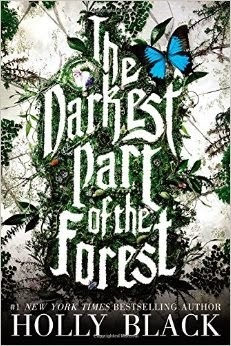
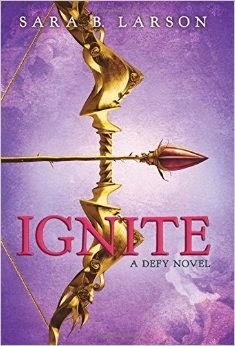
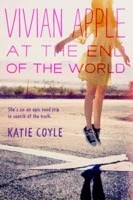
The Darkest Part of the Forest by Holly Black: In the town of Fairfold, where humans and fae exist side by side, a boy with horns on his head and ears as pointed as knives awakes after generations of sleep in a glass coffin in the woods, causing Hazel to be swept up in new love, shift her loyalties, feel the fresh sting of betrayal, and to make a secret sacrifice to the faerie king.
Why: A new Holly Black book is always going to end up on a radar list.
Ignite by Sara B. Larson: King Damian and his trusted guard, Alexa, focus on rebuilding Antion after years of war and strife, but the citizens are reluctant to trust their new king, and when a new threat arises, including an assassination attempt, Alexa must protect the king she loves and uncover the enemy before it is too late.
Why: This is the sequel to Larson's debut Defy, which won over many readers.
Vivian Apple at the End of the World by Katie Coyle: Sixteen-year-old Vivian Apple returns home after the alleged 'Rapture' to find her devout parents gone and two mysterious holes in the roof. Vivian never believed in the Rapture, or the uber powerful Church of America. Now that she has been left behind, Vivan's quest for the truth begins.
Why: The first of many rapture/cult books in 2015 (more to come on this trend soon), Coyle's debut was an award-winner in the UK, with a ton of buzz about it happening on Tumblr.
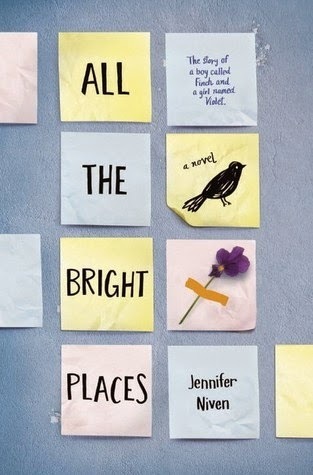


All The Bright Places by Jennifer Niven: Told in alternating voices, when Theodore Finch and Violet Markey meet on the ledge of the bell tower at school--both teetering on the edge--it's the beginning of an unlikely relationship, a journey to discover the "natural wonders" of the state of Indiana, and two teens' desperate desire to heal and save one another
Why: One of the biggest buzz titles I've seen in a long time. It has been compared non-stop to The Fault in Our Stars and Eleanor and Park.
The Boy in the Black Suit by Jason Reynolds: Soon after his mother's death, Matt takes a job at a funeral home in his tough Brooklyn neighborhood and, while attending and assisting with funerals, begins to accept her death and his responsibilities as a man.
Why: I'm going to review this one shortly, but it's a realistic YA novel about a black boy dealing with grief, loss, and first love in Brooklyn. Reynolds's debut, When I Was The Greatest, garnered a lot of well-earned praise last year, and his sophomore effort is even better.
X by Ilyasah Shabazz with Kekla Magoon: Co-written by Malcolm X's daughter, this riveting and revealing novel follows the formative years of the man whose words and actions shook the world. Malcolm Little's parents have always told him that he can achieve anything, but from what he can tell, that's a pack of lies⁰́₄after all, his father's been murdered, his mother's been taken away, and his dreams of becoming a lawyer have gotten him laughed out of school. There's no point in trying, he figures, and lured by the nightlife of Boston and New York, he escapes into a world of fancy suits, jazz, girls, and reefer. But Malcolm's efforts to leave the past behind lead him into increasingly dangerous territory. Deep down, he knows that the freedom he's found is only an illusion⁰́₄and that he can't run forever. X follows Malcolm from his childhood to his imprisonment for theft at age twenty, when he found the faith that would lead him to forge a new path and command a voice that still resonates today.
Why: It's timely and timeless. What do we know about Malcolm X's adolescence? And more, from his daughter? This has been getting some good buzz.
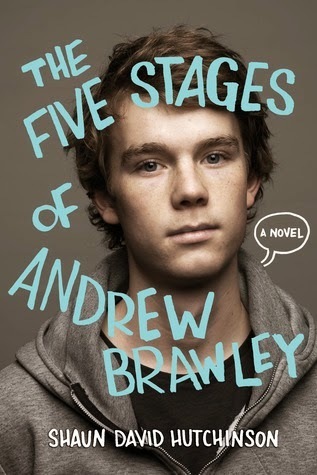
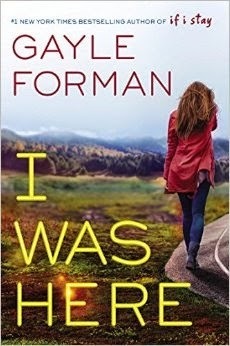
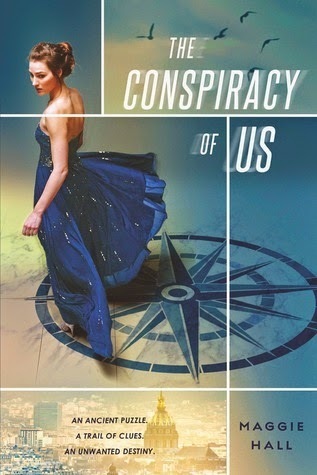
The Five Stages of Andrew Brawley by Shaun David Hutchinson: Convinced he should have died in the accident that killed his parents and sister, sixteen-year-old Drew lives in a hospital, hiding from employees and his past, until Rusty, set on fire for being gay, turns his life around. Includes excerpts from the superhero comic Drew creates.
Why: Aside from being a male-driven narration by Hutchinson -- an up-and-coming author -- it's a graphic novel hybrid, which has loads of reader appeal.
I Was Here by Gayle Forman: In an attempt to understand why her best friend committed suicide, eighteen-year-old Cody Reynolds retraces her dead friend's footsteps and makes some startling discoveries.
Why: It's a new Gayle Forman book, and it's her first standalone title.
A Conspiracy of Us by Maggie Hall: When sixteen-year-old Avery West learns her family is part of a powerful and dangerous secret society, and that her own life is in danger, she must follow a trail of clues across Europe.
Why: This is a debut thriller, and it's one I have received numerous review (and finished!) copies of recently. It looks like it has a real Ally Carter feel to it.



All Fall Down by Ally Carter: There are many powerful people along Embassy Row who want Grace to block out all her unpretty thoughts. But Grace will not stop until she finds out who killed her mother and make the killer pay.
Why: Speaking of Ally Carter, this is the start of a brand new series from her.
Audacity by Melanie Crowder: A historical fiction novel in verse detailing the life of Clara Lemlich and her struggle for women's labor rights in the early 20th century in New York.
Why: This is another that I'll be reviewing soon, but it's included here because it's a historical verse novel about women and the labor rights movements of the early 20th century. Though fictional, the story is based on a real Russian Jewish woman whose family was forced to immigrate to the US.
Fairest by Marissa Meyer: Queen Levana is a ruler who uses her "glamour" to gain power. But long before she crossed paths with Cinder, Scarlet, and Cress, Levana lived a very different story - a story that has never been told . . . until now
Why: It's another addition to Meyer's best-selling Lunar Chronicles series.







 Related StoriesA Few Cybils Reads - Part X2015 YA Book Cover Trends: Part IIReviews, Reviews, Reviews
Related StoriesA Few Cybils Reads - Part X2015 YA Book Cover Trends: Part IIReviews, Reviews, Reviews
Published on January 04, 2015 22:00



